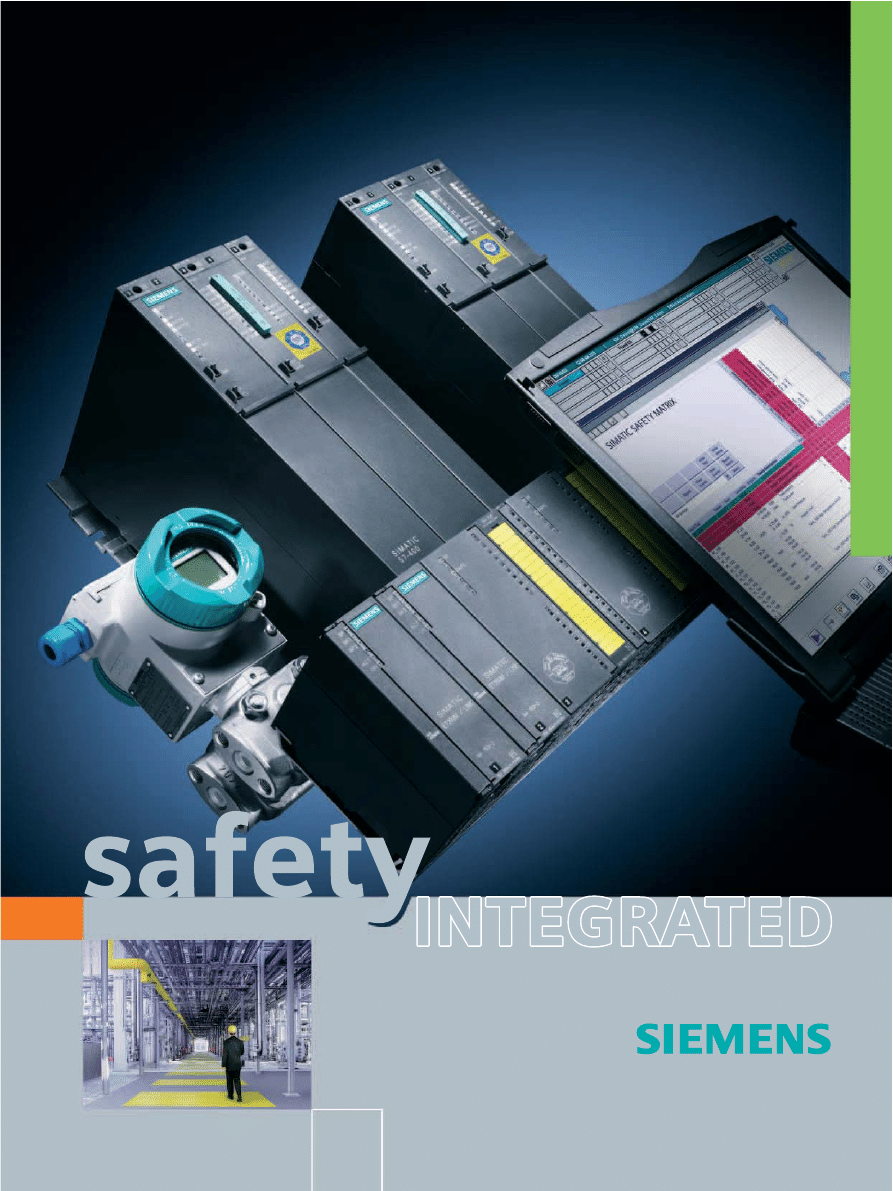
Safety Integrated for Process Automation
Reliable, Flexible, Easy
Br
ochu
re
·
November 2007
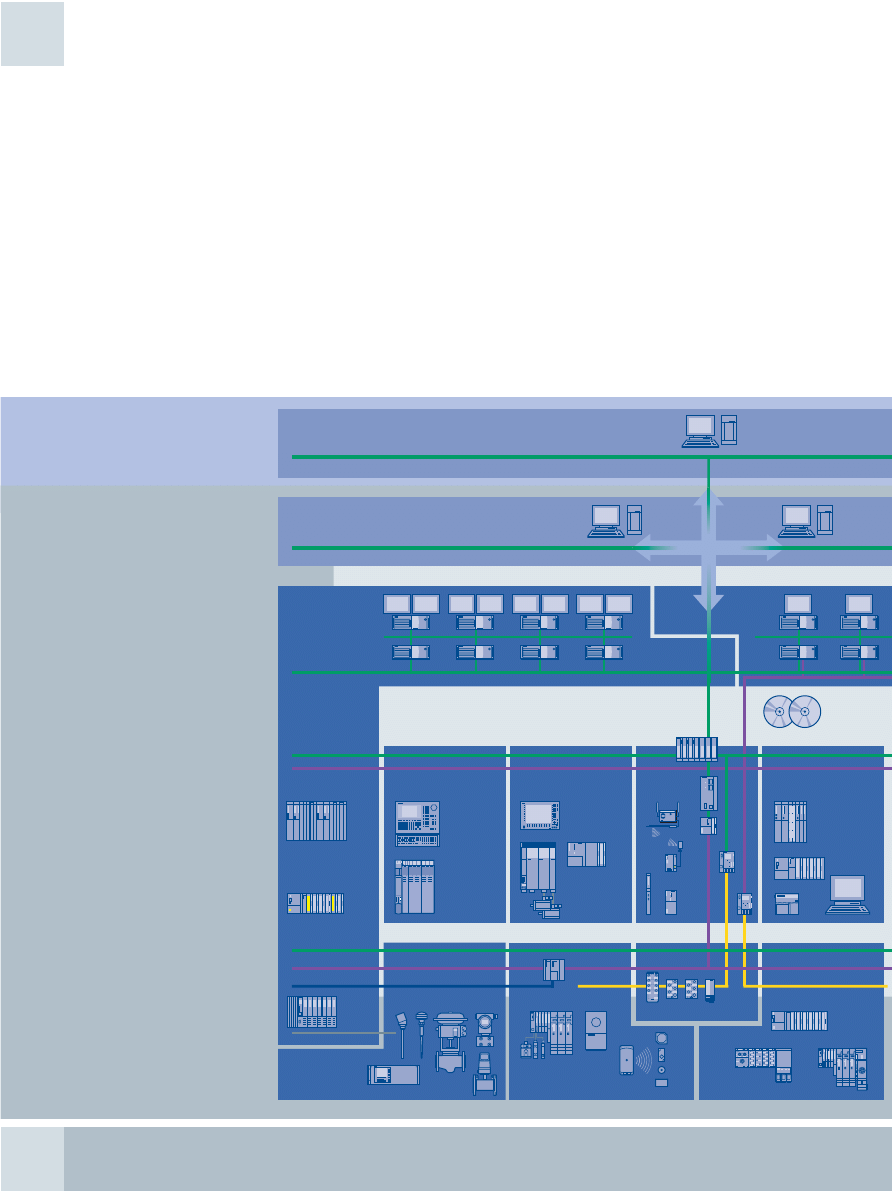
2
Safety Integrated for Process Automation
Totally
Integrated
Automation
Control Level
Operations Level
Field Level
Management Level
SIMATIC Controllers
Modular/Embedded/PC-based
ERP Enterprise Resource Planning
MES Manufacturing Execution Systems
Ethernet
Ethernet
SIMATIC IT
SIMOTION
Motion Control System
SIMATIC PCS 7
Process Control (DCS)
SINUMERIK
Computer Numeric Control
Maintenance
Modernization
and Upgrade
Industrial Software for
Design and Engineering
Installation and Commissioning
Operation
SIMATIC NET
Industrial
Communication
PROFIBUS PA
SIMATIC Distributed I/O
SIMATIC Sensors
Process Instrumentation
HART
AS-Interface
Industrial Ethernet
Totally Integrated Automation
With Totally Integrated Automation (TIA), Siemens is the only
provider of a uniform range of products and systems for auto-
mation in all sectors – from incoming raw materials to out-
going products, covering the field level, control level and pro-
duction control level (Manufacturing Execution System, MES),
and including the corporate management level (Enterprise
Resource Planning, ERP, e.g. SAP).
Thanks to the integration of safety-related functions in TIA,
standard and safety-related automation system components
are combined in one uniform overall system. The benefit: sig-
nificant cost savings for plant constructors and owners.
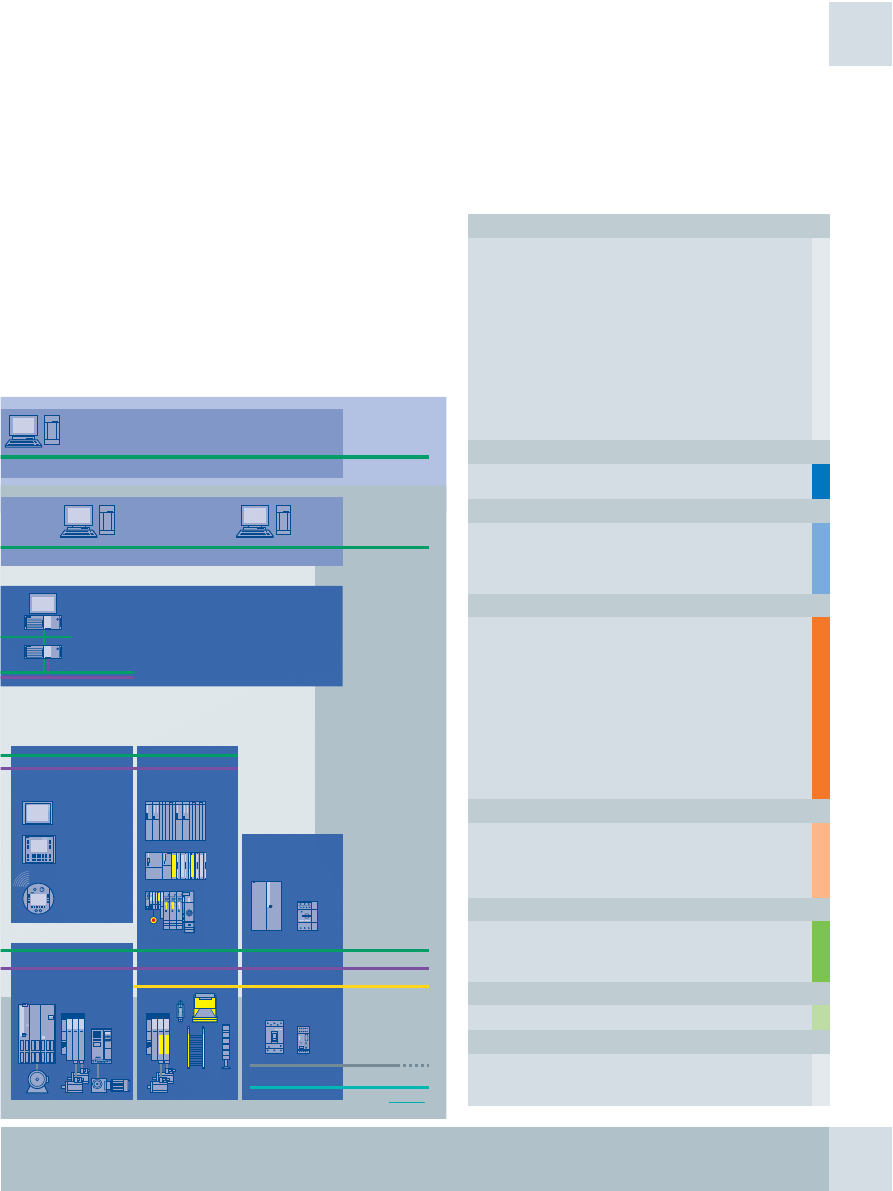
Safety Integrated for Process Automation
3
Safety Integrated
SIMATIC HMI
Human Machine Interface
Totally
Integrated
Power
SIRIUS Industrial Controls
SENTRON Switching Devices
SIMOCODE pro
Motor Management System
SIMATIC WinCC
SCADA-System
AS-Interface
PROFIBUS
PROFINET
Industrial Ethernet
SINAMICS Drive Systems
GAMMA instabus
KNX/EIB
Contents
Safety engineering from Siemens
Process automation with integrated safety . . . . . . . . 4
Standardized, flexible safety products and
solutions from a reliable partner. . . . . . . . . . . . . . . . . 6
Safety lifecycle management with support from
highly qualified Solution Partners . . . . . . . . . . . . . . . 7
Simple control system integration / variable
fieldbus communication with integrated safety . . . . 8
Flexible and scalable fault tolerance/
efficient safety lifecycle engineering . . . . . . . . . . . . . 9
Safety Integrated for process automation –
the comprehensive range of products and services . 10
Integrated control & safety
SIMATIC PCS 7 – complete integration of the
Safety Instrumented System . . . . . . . . . . . . . . . . . . . 12
Safety Integrated fieldbus technology
Uniform field communication
with flexible PROFIBUS architectures . . . . . . . . . . . . 14
PROFIsafe – the safety-related
PROFIBUS communication. . . . . . . . . . . . . . . . . . . . . 15
Flexible Modular Redundancy (FMR)
Cost-optimized safety through flexible
and scalable fault tolerance . . . . . . . . . . . . . . . . . . . 16
Configuration options with FMR . . . . . . . . . . . . . . . . 17
SIMATIC controller for safety-related
process applications. . . . . . . . . . . . . . . . . . . . . . . . . . . . . 19
Versatile, distributed I/O systems . . . . . . . . . . . . . . . 21
Direct device interfacing via fieldbus
with high safety and availability . . . . . . . . . . . . . . . . 25
Safe field instrumentation on the PROFIBUS PA . . . . 26
Safety lifecycle management
Analysis phase . . . . . . . . . . . . . . . . . . . . . . . . . . . . . . 27
Realization phase. . . . . . . . . . . . . . . . . . . . . . . . . . . . 28
Operation and maintenance phase. . . . . . . . . . . . . . 30
Application examples
Partial Stroke Test (PST) . . . . . . . . . . . . . . . . . . . . . . 31
Applications for protection against excess pressure,
fire and gas as well as for burner management . . . . 33
Reference projects
References in oil & gas and chemical industries . . . 34
Overview of product and ordering data
Controllers, software components, F modules,
terminal modules, distributed I/O system,
safety packages . . . . . . . . . . . . . . . . . . . . . . . . . . . . . 36

4
Safety engineering from Siemens
Process automation with integrated safety
Safe at all times
In the process industries it is not uncommon to find hazardous
processes. These hazards may arise from the materials being
processed being toxic, flammable or even potentially explo-
sive. Alternatively the process itself may be hazardous –
involving high pressures, temperatures or exothermic reac-
tions. Any of these hazards, if not properly addressed, could
lead to fatalities. When dealing with hazardous processes the
safety of personnel, plant equipment and the environment
are of utmost importance but it is also paramount that the sys-
tems put in place to ensure safety do not themselves compro-
mise the production process through spurious trips.
In order to achieve this combination of safety and fault toler-
ance a reliable Safety Instrumented System (SIS) is required,
which can bring the plant to a safe state when necessary but
which can also meet the high availability requirements of the
process industries.
Comprehensive range of Safety Instrumented products
and services
Safety Integrated for Process Automation provides a compre-
hensive range of products and services for fail-safe and fault-
tolerant applications in the process industry. Components
from the Safety Integrated range are combined in a Safety
Instrumented System capable of reacting rapidly to trip condi-
tions to bring the plant to a safe state. All the principal compo-
nents of a typical Safety Instrumented System are available
from Siemens including fail-safe instrumentation, fail-safe
and fault-tolerant control, up to the actuators.
Completely integrated in the standard automation
The SIMATIC S7-400FH controller with its matching I/O offers
a maximum degree of safety, fault-tolerance and availability
for your applications. From a fail-safe transmitter on PROFIBUS
at the field level, up to the SIMATIC PCS 7 process control
system: with our offering you can implement efficient and
flexible solutions for automation and safety applications in a
totally integrated complete system.
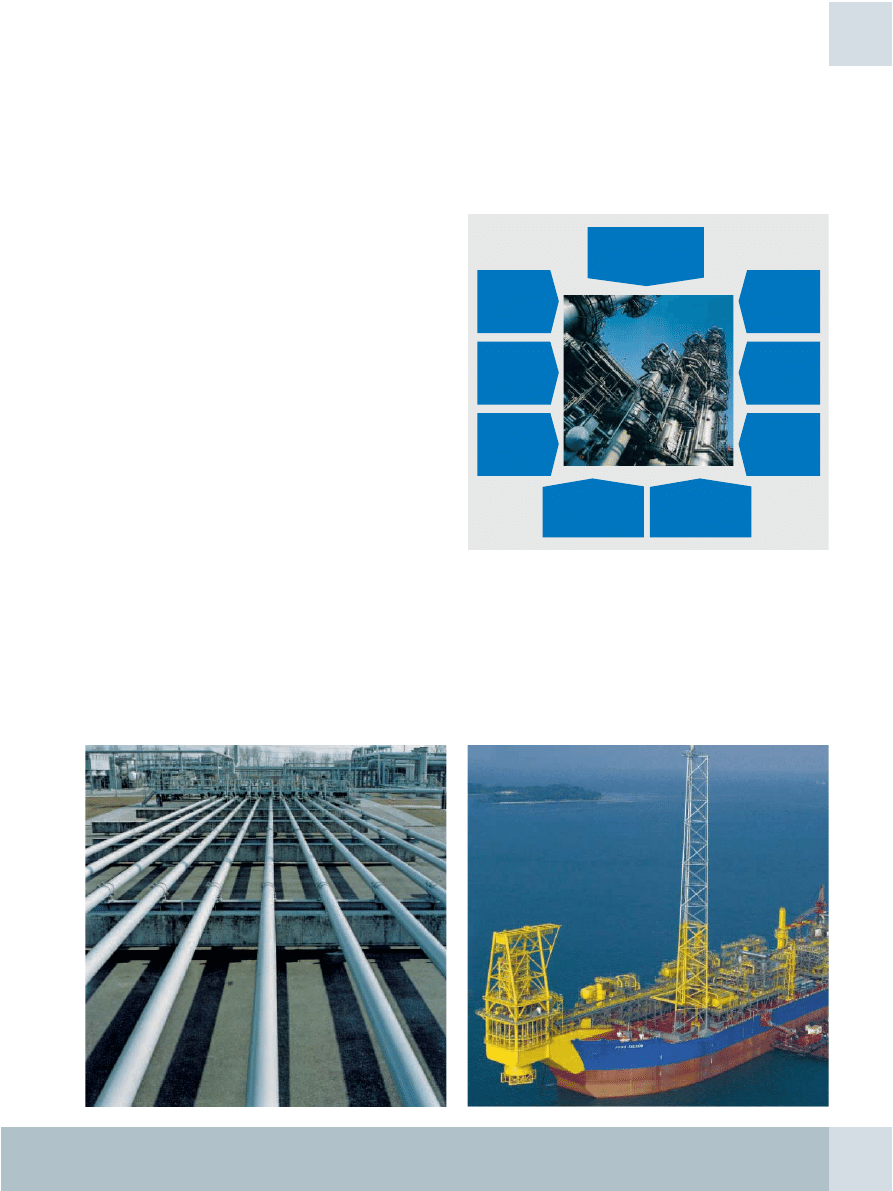
Safety engineering from Siemens
5
SIMATIC PCS 7 safety & security
Increased use of open standards and global networking
is unfortunately also associated with increased cyber crime.
Numerous threats result due to malware or unauthorized
access, e.g.:
■
Overloading or failure of networks
■
Espionage and stealing of passwords or process data
■
Unauthorized access to Process Automation Systems
■
Direct sabotage
In order to protect plants using the SIMATIC PCS 7 process con-
trol system, Siemens has developed an extremely effective,
holistic safety concept which links together a wide range of
security measures which are being continuously upgraded.
However, absolute safety cannot be guaranteed even with all
the known security measures. By combining SIMATIC PCS 7
IT security with safety engineering, you can neutralize the ef-
fects of cyber crime or limit them to a tolerable degree.
SIMATIC PCS 7 safety and security measures
More information on the Internet at
www.siemens.com/pcs7/safety_security
Segmentation
of the plant
(Security
cells)
Network:
subnetworks,
IP addresses,
Name
resolution
Defense-in-depth
security
architecture
Active
Directory
domains
work groups
Service access
and remote
maintenance
(VPN, IPSec)
Virus
protection
and
Firewalls
Time-of-day
synchronization
User management
and authorization
management
Windows
security
Patch
management

6
Safety engineering from Siemens
Standardized, flexible safety products and solutions from a
reliable partner
A complex network of standards and directives ...
As a plant owner, you are required by government regulation
to ensure safety for personnel and the environment. To
achieve this, all rules, directives and orders must be imple-
mented at the plant location. A hazard and risk analysis must
be carried out if a potential hazards exist. This describes the
existing risks and the current and additional measures
required to reduce these risks to a level which is as low as
reasonably practicable (ALARP).
Safety lifecycle activities must be comprehensively docu-
mented (e.g. safety plans, safety requirement specifications)
to ensure that a consistent approach to safety is maintained
throughout the analysis, realization and operation phases of
the plant.
Maximum availability must be additionally guaranteed
depending on the requirements, for example through Flexible
Modular Redundancy (FMR). In this manner, flexible and
scalable redundancy of up to 100% is simple to achieve.
... and a reliable partner which supports you to comply
with all requirements.
For more than 25 years already, Siemens as a reliable industri-
al partner has been implementing first-class automation solu-
tions for process safety in a wide range of sectors. Our solu-
tions feature maximum efficiency, and provide users with
significant potential savings whilst complying, of course,
with the applicable national and international standards, e.g.
IEC 61508 (up to SIL 3) and IEC 61511.
IEC 61508 - basic standard
IEC 61508 defines methods to achieve the functional safety of
products. Compliance with it is verified by corresponding cer-
tificates. The standard is globally applicable, and serves as the
basis for specifications and for the design and operation of
Safety Instrumented Systems.
IEC 61511 - application-specific standard
for the process industry
IEC 61511 adapts IEC 61508 to the process industry. It mainly
serves as a guideline for planning, implementing and operat-
ing Safety Instrumented Systems in process plants. An impor-
tant component is the demand for documentation of all
changes during the complete lifecycle of the plant as part
of the Functional Safety Management requirements.
Safety Integrity Level (SIL)
IEC 61508 and IEC 61511 define four different safety integrity
levels (SIL 1-4). The SIL is a measure of the probability that
a specific safety instrumented function (SIF) will operate
successfully should a demand occur. A higher SIL level corre-
sponds to a greater level of risk reduction. The use of certified
safety components is helpful in ensuring each SIF meets its
required SIL.
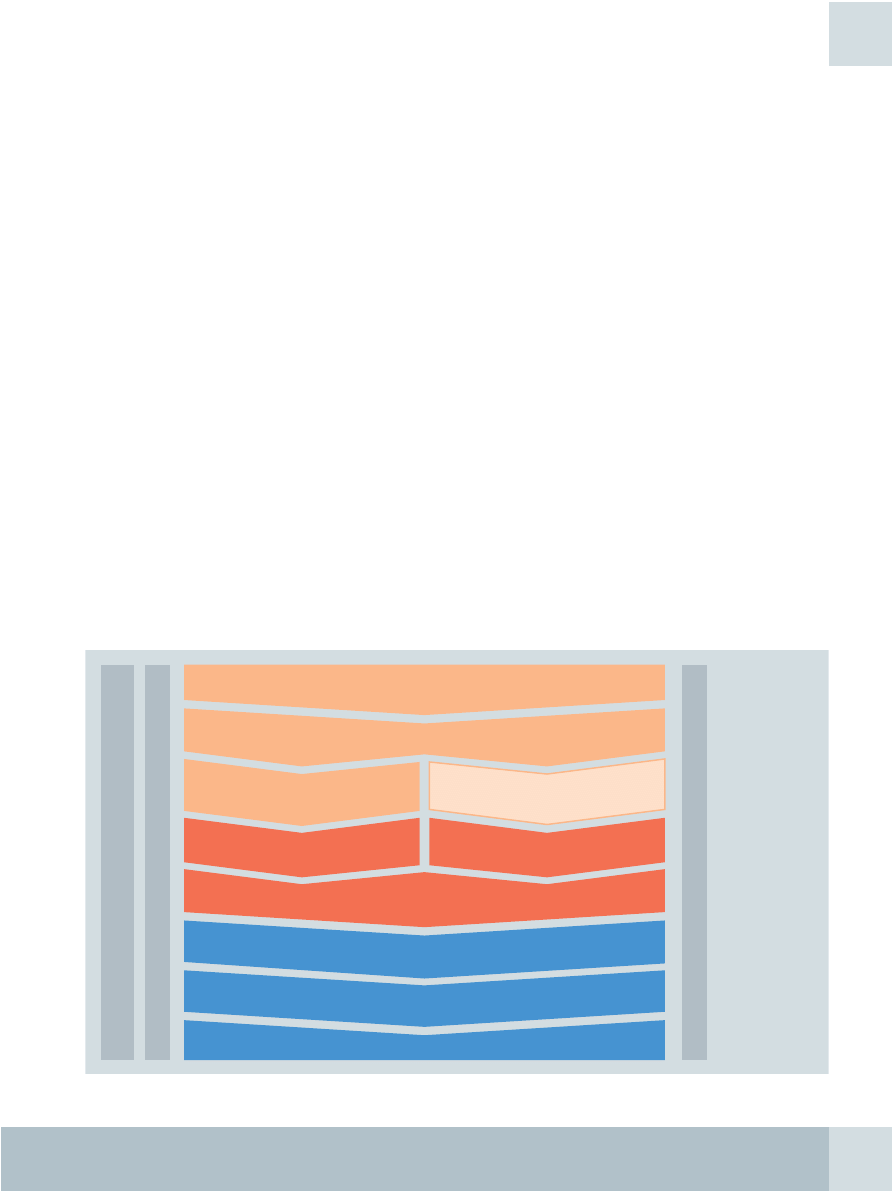
Safety engineering from Siemens
7
Safety lifecycle management
with support from highly qualified Solution Partners
The safe way to a reliable plant:
Safety lifecycle management
IEC 61511 stipulates the proof of safety for the complete safe-
ty loop, covering the sensor, controller up to the actuator. Not
only the individual products are considered, but the complete
lifecycle of a plant – covering risk analysis, planning, installa-
tion and operation up to taking out of operation.
We provide you with support during the complete lifecycle of
your Safety Instrumented System – and offer a comprehen-
sive range of products, systems and services:
■
Complete and uniform Safety Instrumented System: con-
troller, engineering with the safety lifecycle tool "Safety
Matrix", and fail-safe process instruments
■
Range of services for all lifecycle phases of a Safety Instru-
mented System – including training, documentation and
24/7 round-the-clock servicing
The right local support: Solution Partners
In order to cope with the increasing demands in the safety
engineering sector, Siemens Automation and Drives – in addi-
tion to its standard service & support offering – is also offering
selected "Siemens Solution Partners for Automation". These
are highly qualified partner companies which offer you pro-
fessional consulting and support for all relevant safety as-
pects. The PCS 7 safety specialists are certified Solution Part-
ners for safety within the Process Automation sector. They are
fully familiar with safety engineering in the process industries,
and provide:
■
Know-how concerning the IEC 61511 safety lifecycle
■
Knowledge of safety engineering with S7 F Systems and
SIMATIC Safety Matrix
■
Comprehensive experience in projects with safety applica-
tions in the process industry
You can find more information regarding our partners on
the Internet:
www.siemens.com/automation/solutionpartner
The phases of the safety lifecycle
Analysis
Realization
Operation
Hazard and Risk Assessment
V
erification
Safety Lifecycle Structure and Planning
Management of Functional Safety and
Functional Safety
Assessment and
Auditing
Installation, Commissioning and Validation
Operation and Maintenance
Modification
Decommissioning
Design and Engineering of
Safety Instrumented System (SIS)
Safety Requirements Specification (SRS)
for the Safety Instrumented System (SIS)
Design and Development of
other means of Risk Reduction
Allocation of Safety Functions to Protection Layers
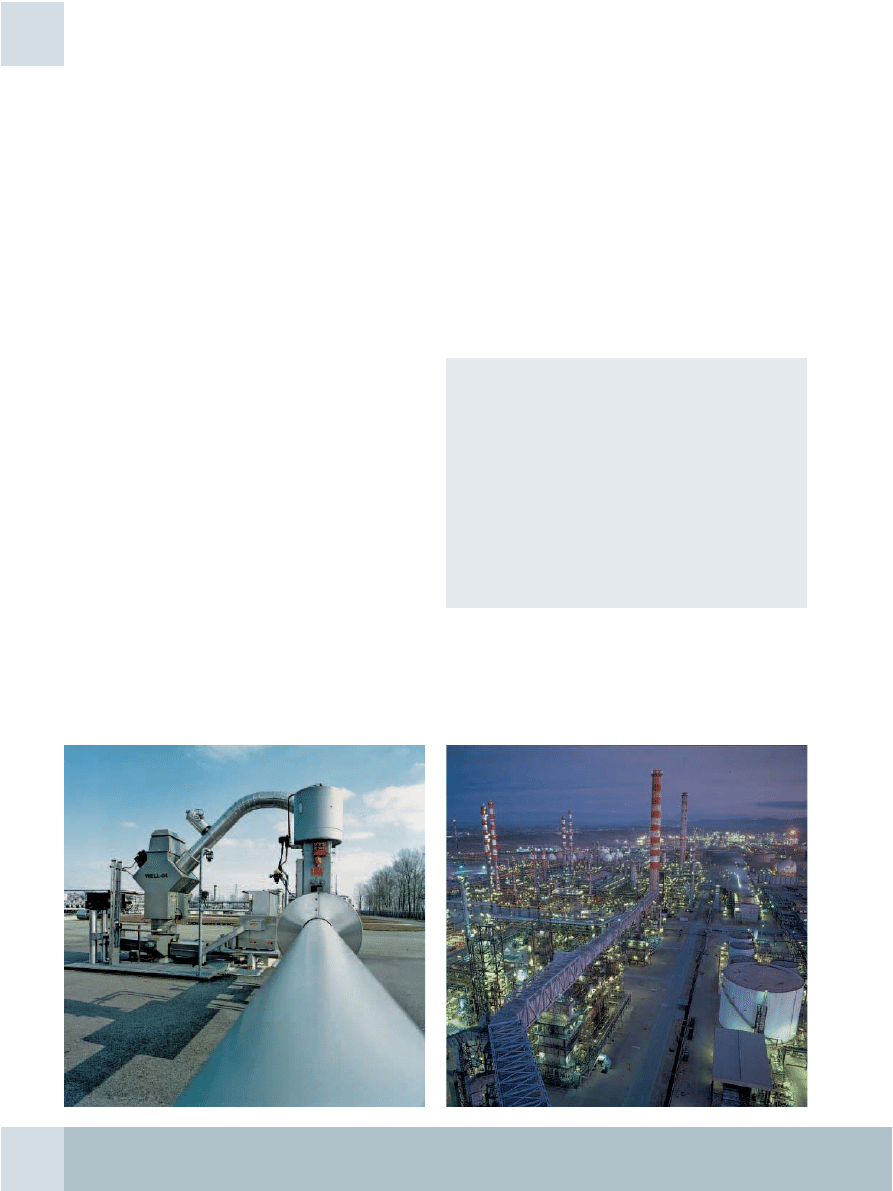
8
Safety engineering from Siemens
Simple control system integration /
variable fieldbus communication with integrated safety
Simple integration into control system
Our innovative Safety Instrumented System can be
connected to any digital control system (DCS) when using
SIMATIC S7-400FH, SIMATIC ET 200M and ET 200S as well
as SITRANS P. The facility for integration in our innovative-
SIMATIC PCS 7 process control system is unique in this con-
text. This combination provides shorter engineering times, a
better operating performance, savings from reduced stocking
of spare parts, and lower total maintenance costs.
Common interfacing using proven standards
The proven PROFIBUS DP and PROFIBUS PA fieldbus technolo-
gy is used when connecting standard and safety-related
I/O modules and devices. Safety-related and standard com-
munication use the same bus medium. This also applies to the
interfacing of fail-safe pressure transmitters, for example the
SITRANS P DS III to PROFIBUS PA with PROFIsafe according to
SIL 2 (proven in use).
Safety Integrated fieldbus technology with PROFIsafe permits
certified fail-safe communication between controllers, distrib-
uted safety I/O and safety-related process instruments. Redun-
dancy or ring structures at all levels of fieldbus communica-
tion allow maximum availability.
Advantages at a glance
■
One engineering system for process control and
process safety applications
■
SIMATIC S7-400FH, one common controller platform
for SIMATIC PCS 7 and process safety
■
Direct and seamless communication between DCS
and SIS
■
Automatic integration of various safety-related alarms
and messages with time stamping
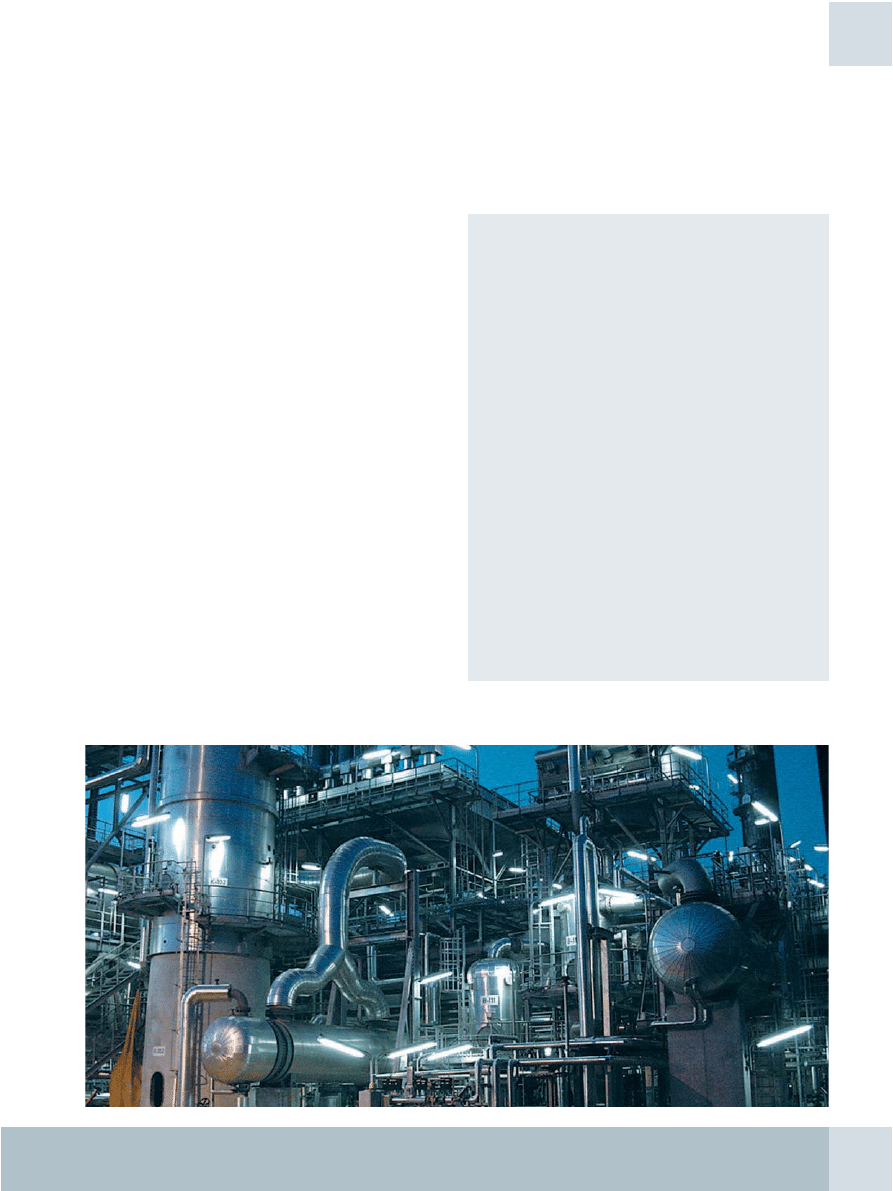
Safety engineering from Siemens
9
Flexible and scalable fault-tolerance /
efficient safety lifecycle engineering
Well thought-out concept for higher availability
The Flexible Modular Redundancy offered by Siemens is an
innovative concept for implementing scalable, cost-effective
solutions. Multiple fault-tolerance levels can then be imple-
mented exactly where they are required for the respective
application.
Significantly simpler engineering throughout the com-
plete safety lifecycle
The standard and safety programs are generated in the proven
SIMATIC Manager – with or without SIMATIC PCS 7. This reduc-
es training requirements in addition to engineering costs. You
design the safety section of the program using Continuous
Function Chart (CFC) or SIMATIC Safety Matrix, the innovative
and convenient tool for safety lifecycle engineering and man-
agement. To this end, you use TÜV-certified function blocks
from the library in S7 F Systems.
SIMATIC Safety Matrix operating uses the Cause&Effect
methodology significantly reducing the overhead for engi-
neering, commissioning and maintenance – with automatic
compatibility with IEC 61511.
Advantages at a glance
■
Flexible Modular Redundancy (FMR)
– I/O and field device redundancy independent of
CPU redundancy
– No time-limited safety operation in event of com-
ponent failure (degraded mode)
– Selection of redundancy matching the Safety
Instrumented Function (SIF)
– Safety not a function of redundancy
■
SIMATIC Safety Matrix
– Configuration of safety functions using the proven
Cause&Effect methodology
– Automatic generation of safety logic in CFC
– User-friendly display of the Safety Matrix on the
user interface of SIMATIC PCS 7
– Simple tracking of modifications
– Integrated functions for commissioning and main-
tenance (safety lifecycle)
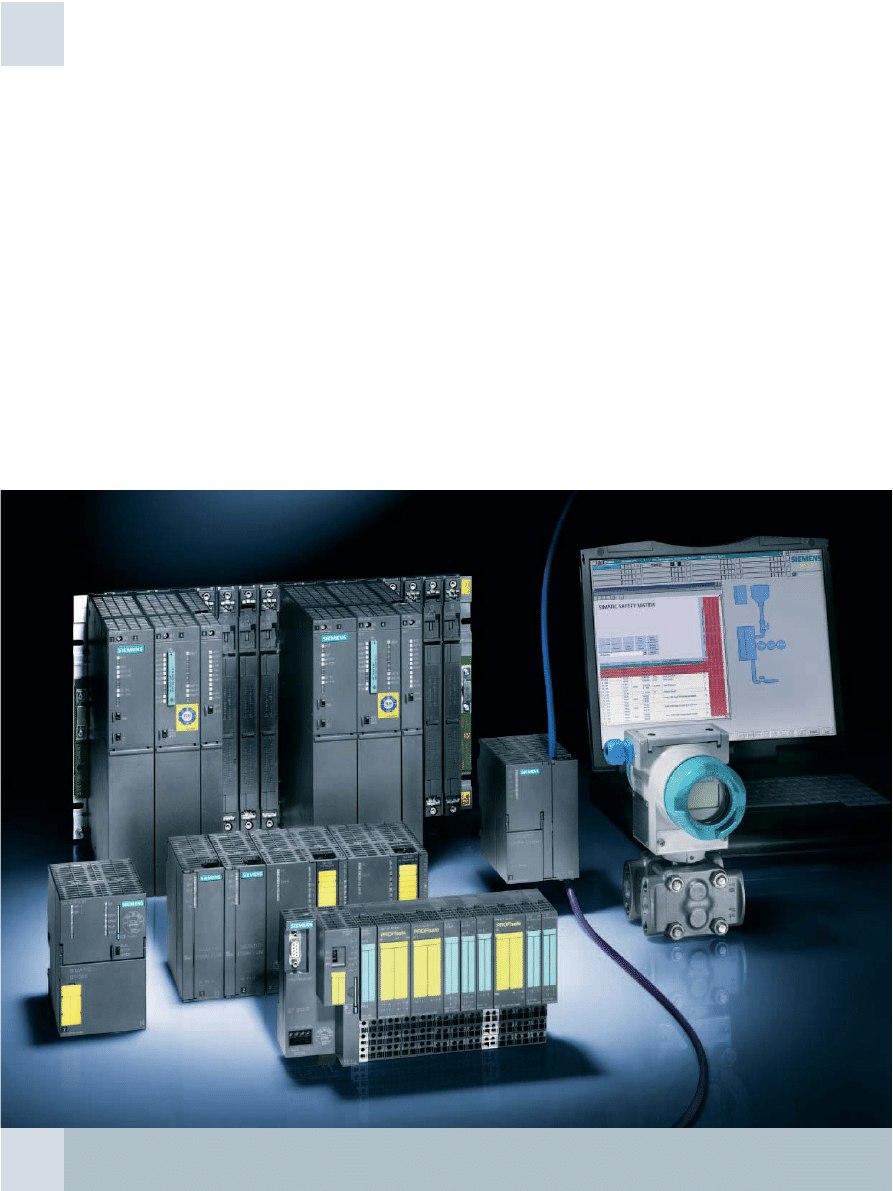
10
Safety engineering from Siemens
Safety Integrated for process automation –
the comprehensive range of products and services
The Safety Instrumented System from Siemens comprises safe
controllers, safe bus systems and I/O as well as safe instru-
mentation, for example for pressure measurements.
With Safety Integrated, we can offer first-class, comprehen-
sive and uniform solutions for the process industries on this
basis, and combine these with excellent services for all stages
in the lifecycle of a Safety Instrumented System.
Because of our complete range and decades of experience, we
can implement first-class automation solutions for process
safety. Our comprehensive range of offers includes:
■
Emergency and process shutdown systems (ESD/PSD)
according to IEC 61511, S84
■
Burner management systems (BMS)
according to EN298, NFPA 85
■
Fire and gas applications (F&G)
according to EN 54, NFPA 72
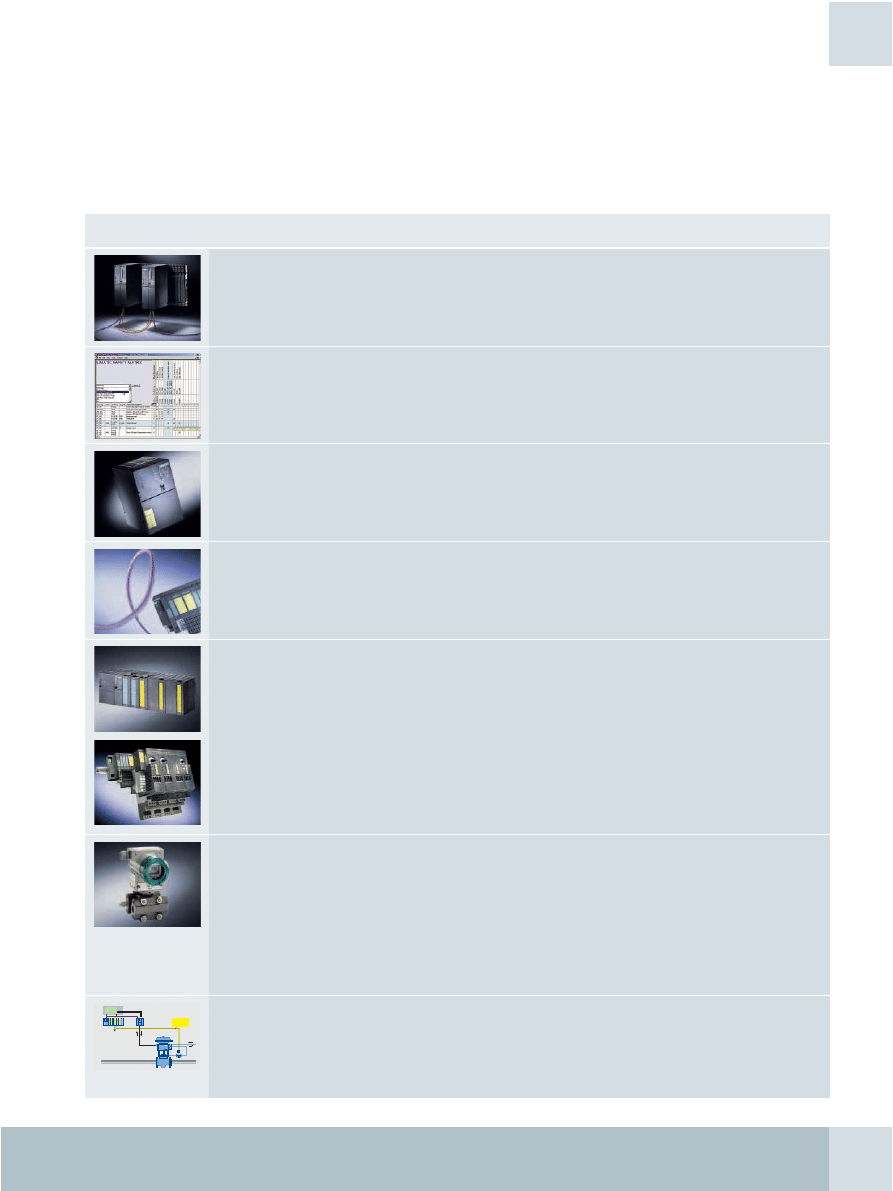
Safety engineering from Siemens
11
Range of products for the process industry
SIMATIC S7-400FH
Fail-safe, fault-tolerant controllers with a redundant or non-redundant
design (up to SIL 3) for the bottom, mid and top performance ranges
Engineering
Engineering of safety functions using Continuous Function Chart (CFC) or
SIMATIC Safety Matrix (Cause&Effect matrix) and TÜV-certified function
blocks (up to SIL 3)
SIMATIC S7-300F
Controller with a non-redundant design (up to SIL 3) for implementing
standard and safety-related automation tasks in the bottom and mid per-
formance ranges
PROFIBUS with PROFIsafe
For standard and safety-related communication on just one bus cable,
certified according to IEC 61508 (SIL 3)
SIMATIC ET 200
ET 200M
Modular I/O for multi-channel applications with digital input and output
modules as well as analog input modules (up to SIL 3)
ET 200S
Bit-modular I/O with digital input and output modules as well as safety-
related motor starters (up to SIL 3)
Process instruments/
process devices
Safe process instruments/devices on PROFIBUS PA:
SITRANS P DS III (SIL 2) pressure transmitters on PROFIBUS PA with
PROFIsafe (proven in use SIL 2)
Safe process instruments/devices for connection to ET 200M remote I/Os:
Pointek CLS 200/300 analog (SIL 2), Pointek ULS 200 (SIL 1),
SITRANS P DS III analog/HART (SIL 2), SITRANS TW series (SIL 1),
SIPART PS2, 2/4-wire (SIL 2)
Applications
- Partial Stroke Test
- Burner libraries
Predefined function blocks and faceplates for online valve test to enable
preventive valve diagnostics without affecting production
Libraries for SIMATIC S7-400FH and S7-300F controllers with TÜV-certi-
fied function blocks for burner management systems
S
ET 200M
SIS controller
DP/PA coupler
Pneumatic shutdown valve
Safety
application
F-AI
F-DO
Safety
Instrumented
Function
Solenoid valve
Air supply
Setpoint for
valve position
Feedback of
valve position
SIPART PS2
valve positioner
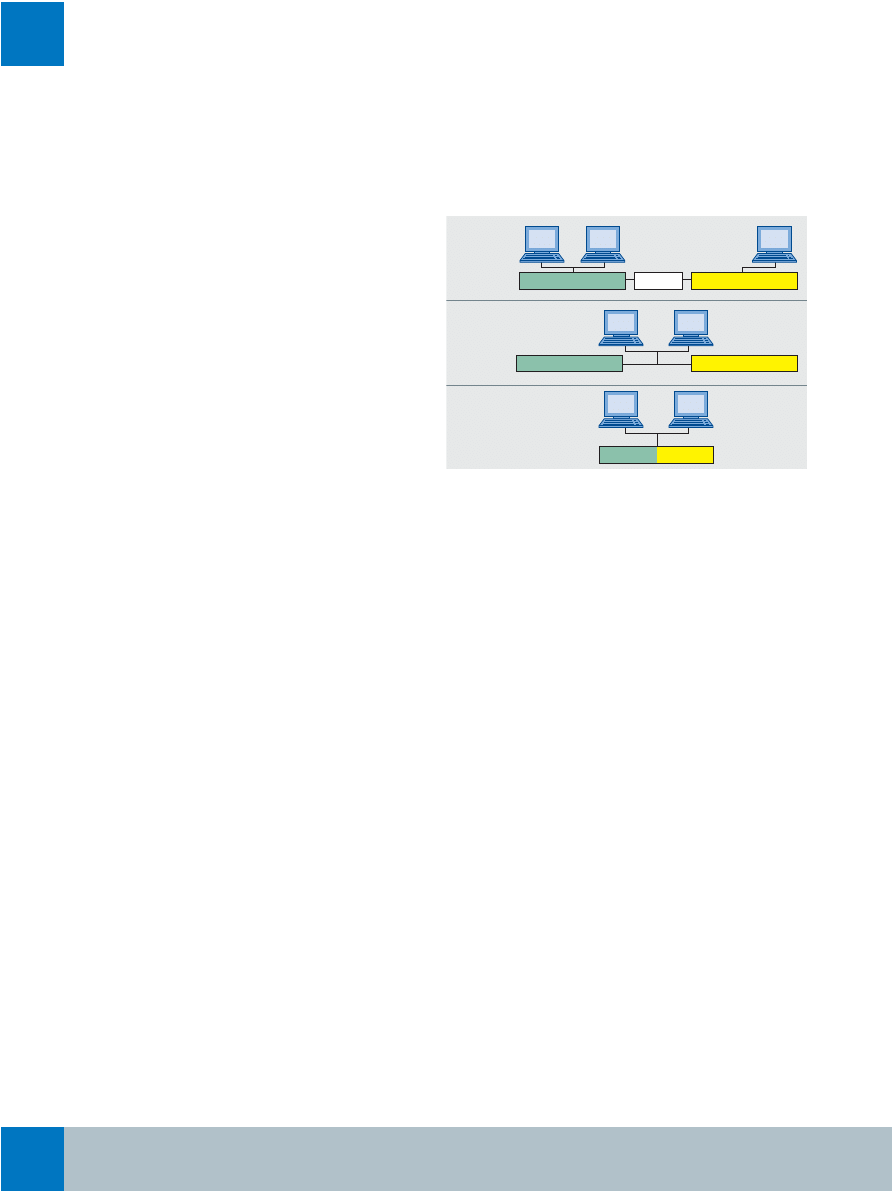
12
Integrated control & safety
SIMATIC PCS 7 –
complete integration of the Safety Instrumented System
Safety Integrated for Process Automation from Siemens al-
lows the best possible type of integration of the Safety Instru-
mented System into the process control system. With this
common integration, the basic process control system (BPCS)
and the Safety Instrumented System are based on common
hardware.
The resulting reduction in required space, scope of hardware
and wiring, as well as assembly, installation and engineering
overheads results in significant cost savings for the complete
lifecycle of the plant.
Thanks to the innovative concept of Safety Integrated, all
other integration levels can also be covered.
A distinction is basically made between the following three
integration levels:
■
Interfaced
The BPCS and the Safety Instrumented System are based on
different hardware, and are connected together by a gate-
way for data exchange. The two systems use separate
engineering tools.
■
Integrated
The BPCS and the Safety Instrumented System are based on
different hardware, but have a uniform communication
system and use a common engineering tool.
■
Common
The BPCS and the Safety Instrumented System are com-
bined in the process control system. They use common
hardware (controller, fieldbus, I/O). Standard and safety-
related programs are executed in parallel and independent
of each other.
The modularity and flexibility of Safety Integrated permit indi-
vidual definition of the degree of integration. For example,
you can decide yourself whether you wish to execute the basic
process control functions and the safety functions in one con-
troller (automation system) or in separate controllers.
Integration levels of the Safety Instrumented System in the process control system
Many of the benefits of a Siemens Safety Instrumented
System can be realized even when it is interfaced to another
open control system using standard communication over
PROFIBUS. These include:
■
Processing of standard and safety functions in one
S7-400H controller
■
Standard communication and safety-related communica-
tion between controller and distributed I/O over PROFIBUS
and PROFIsafe instead of a separate safety bus
■
Mixed operation of standard and safety-related I/O modules in
remote I/O stations of the ET 200M and ET 200S systems
However, the maximum potential of Safety Integrated can
only be utilized through the unique combination with the uni-
versal SIMATIC PCS 7 process control system from Siemens.
You then profit from further advantages such as:
■
One engineering system for basic process control and
safety-related applications
■
Homogenous integration of the safety technology into the
automation system of SIMATIC PCS 7
■
Integration of the safety-related applications into the con-
venient process visualization on the SIMATIC PCS 7 opera-
tor station
■
Automatic consideration of safety-related fault messages
in the process visualization, with time stamping
BPCS SIS
BPCS
BPCS
SIS
SIS
Gateway
ES
ES
OS
ES OS
ES OS
Interfaced
Integrated
Common
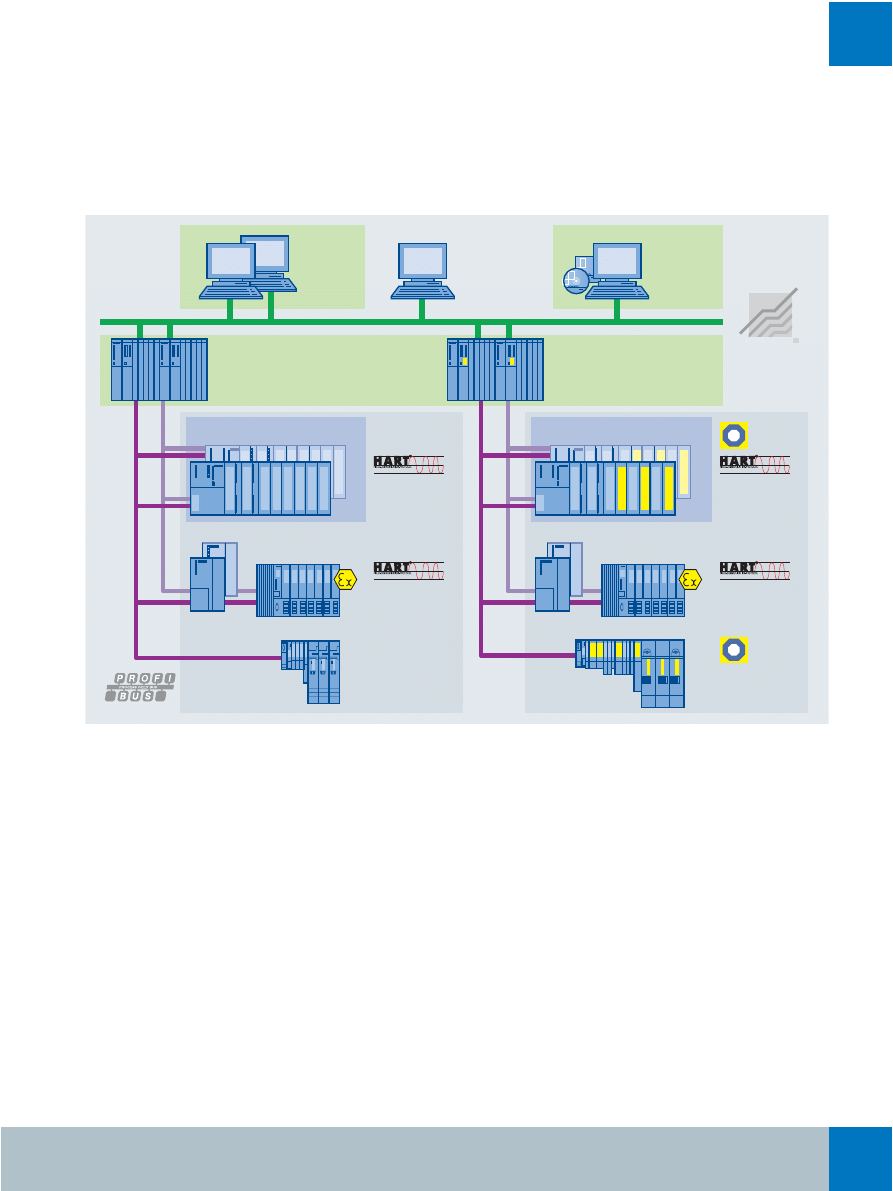
Integrated control & safety
13
Basic process control system and Safety Instrumented System combined in the SIMATIC PCS 7 process control system
■
Uniform data management for basic process control and
safety-related automation, including process visualization
and diagnostics, therefore no complex data management
between BPCS and SIS
■
Integration of safety-related hardware into the SIMATIC
PCS 7 asset management for diagnostics and preventive
maintenance
The safety system usually communicates over the plant bus (with
client/server systems also over a terminal bus (OS-LAN) if neces-
sary) with systems and tools for engineering, process control,
plant management, diagnostics and maintenance. In the case of
modern, open process control systems, the plant and terminal
buses are usually industry-compatible Ethernet LANs. In the GUI
of these systems and tools, the Safety Integrated System is rep-
resented by operator-accessible faceplates.
The Safety Integrated System is integrated into the plant bus
using rugged Ethernet interface modules in the controllers
and Industrial Ethernet Switches such as ESM, OSM or
SCALANCE X as suitable for the bus medium used.
The SIMATIC PCS 7 plant bus based on Industrial Ethernet ac-
cording to the IEEE 802.3 standard is often designed as an op-
tical ring for noise immunity and availability reasons. It can
also be configured as a redundant optical ring if very high
availability demands exist, and this tolerates double faults
such as the failure of a switch on Ring 1 and a simultaneous
open-circuit in the bus cable of Ring 2.
The terminal bus of SIMATIC PCS 7 can also be distributed be-
tween two redundant rings which are connected together using
two pairs of SCALANCE X switches with "standby redundancy".
TÜV
TÜV
Industrial
E
thernet
ET 200S
Operator
system
High-availability
Fail-safe, fault-tolerant
and high-availability
ET 200M
redundant/non-redundant
ET 200iSP
redundant/
non-redundant
ET 200S
Standard/
safety-related
Standard/
safety-related
Standard
ET 200M
redundant/non-redundant
ET 200iSP
redundant/
non-redundant
Standard
Standard
Standard
Engineering
system
Maintenance
station
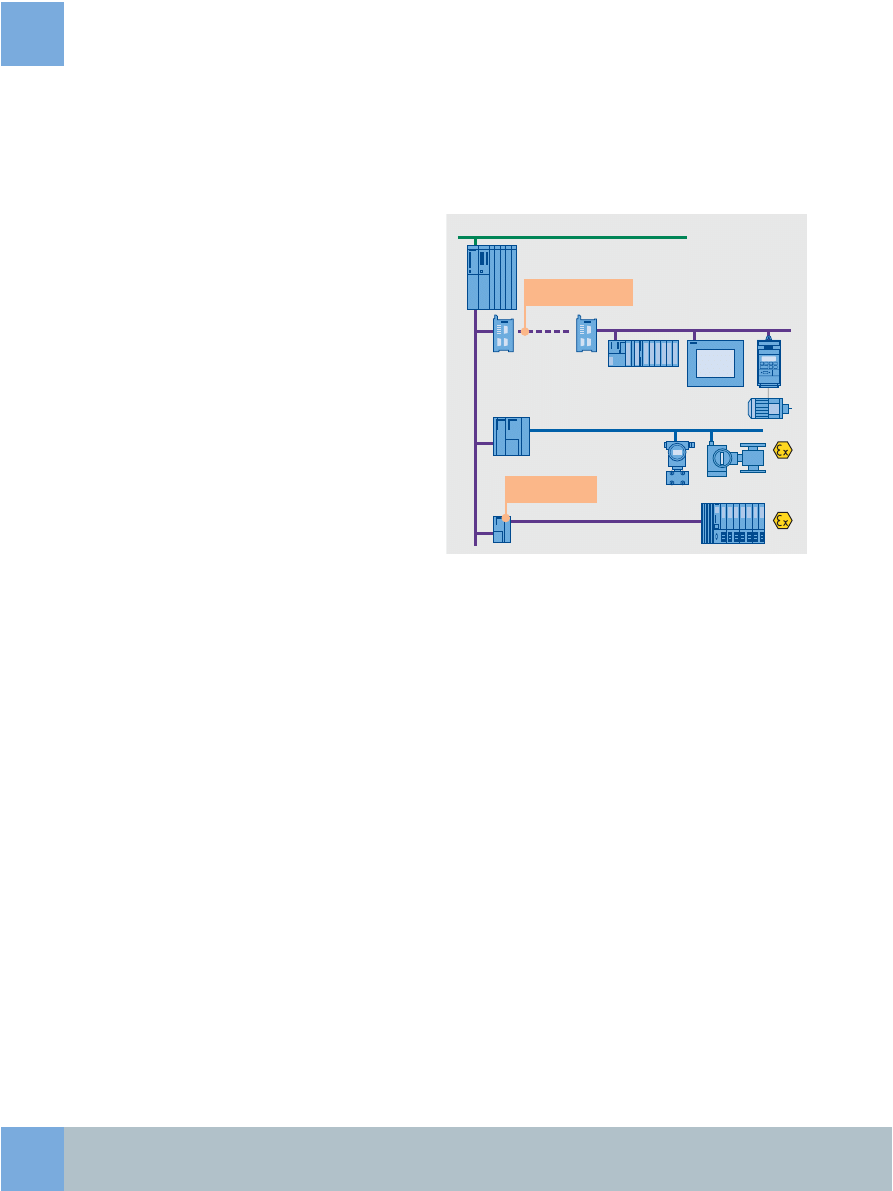
14
Safety Integrated fieldbus technology
Uniform field communication
with flexible PROFIBUS architectures
Distributed peripherals such as remote I/O stations with their
I/O modules, transmitters, drives, valves or operator terminals
communicate with the controllers at field level through a
powerful real-time bus system. This communication is
characterized by
■
cyclic transmission of process data, and
■
acyclic transmission of alarms, parameters and diagnostics
data.
PROFIBUS is well suited to these tasks because it enables high-
speed communication with the intelligent distributed I/Os by
means of a communications protocol (PROFIBUS DP) as well as
communication and simultaneous power supply for transmit-
ters and actuators (PROFIBUS PA). PROFIBUS is simple, rugged
and reliable, can be expanded online by further distributed
components, and can be used in both standard environments
and hazardous areas.
In addition, it offers versatile facilities for communication and
line diagnostics, as well as for diagnostics of the intelligent
field devices connected. Furthermore, it is fully integrated
into the global asset management of the SIMATIC PCS 7 pro-
cess control system.
PROFIBUS supports the coexistence of field devices from dif-
ferent vendors in one segment (interoperability) as well as the
vendor-independent replacement of devices from within a
profile family.
PROFIBUS transmission systems
In addition to all these properties, the following PROFIBUS
functions are particularly relevant to process automation:
■
Integration of previously installed HART devices
■
Redundancy
■
Safety-related communication with PROFIsafe up to SIL 3
according to IEC 61508
■
Time synchronization
■
Time stamping
The PROFIBUS PA fieldbus developed for direct linking of
sensors and actuators is integrated into PROFIBUS DP over a
redundant or non-redundant router. Using a non-redundant
router, a PROFIBUS PA of line or tree topology can be imple-
mented on a redundant or non-redundant PROFIBUS DP.
Higher availability is achieved by the redundant router in
combination with a line or ring topolgy. A configuration with
a redundant router and ring topology is able to tolerate single
faults such as the failure of a DP/PA coupler or an open-circuit
in the bus cable.
PROFIBUS DP
PROFIBUS PA
PROFIBUS DP
OLM OLM
Industrial Ethernet
RS 485-iS coupler
Long distances
with fiber-optic
DP/PA link
Automation system
Ex isolation
+ repeater
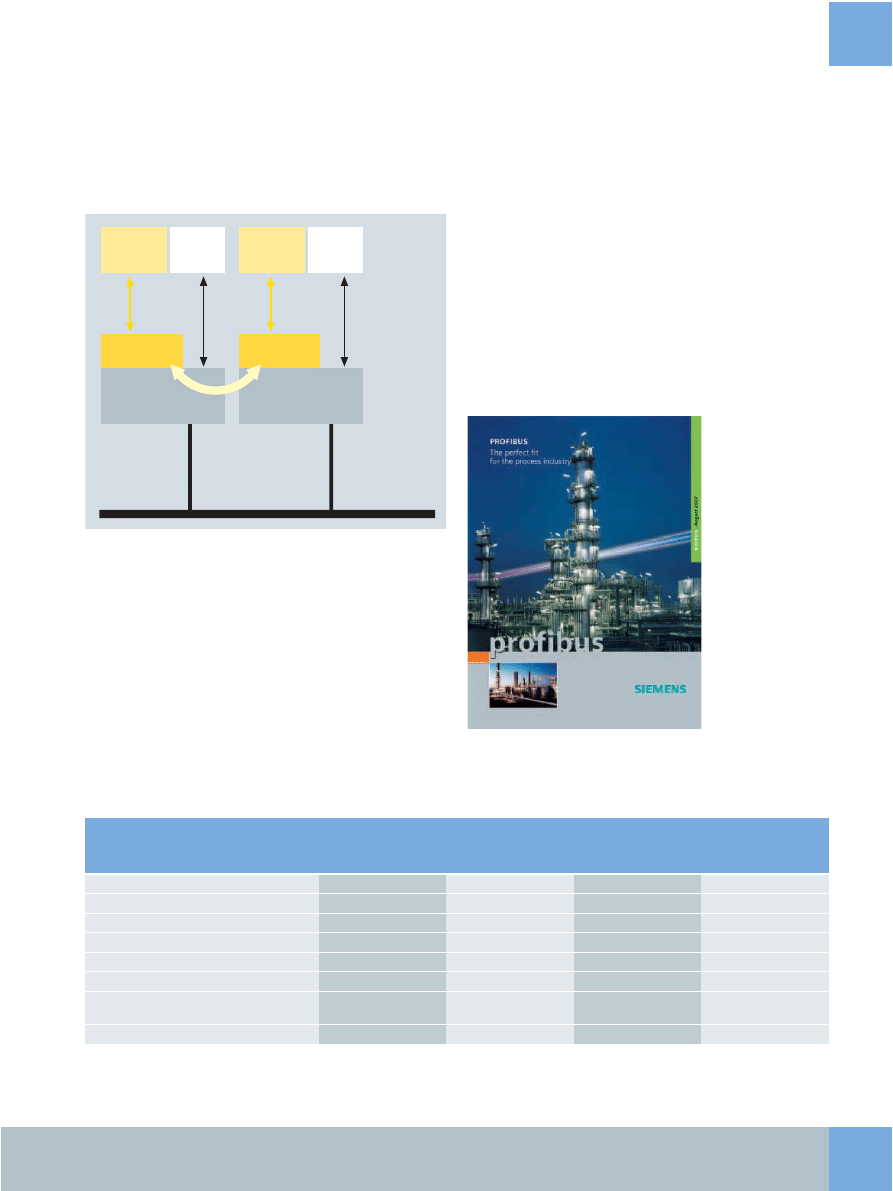
Safety Integrated fieldbus technology
15
PROFIsafe –
the safety-related PROFIBUS communication
Standard and safety-related data are transmitted over the same bus line with
PROFIsafe. Collision-free communication is possible over a bus system with me-
dia-independent network components.
The PROFIsafe profile is implemented as an additional soft-
ware layer within the devices/systems without modifying
the communication mechanisms of standard PROFIBUS.
PROFIsafe expands the telegrams by the addition of informa-
tion with which the PROFIsafe communications partners can
recognize and compensate transmission errors such as delays,
incorrect sequences, repetitions, losses, faulty addressing or
data falsification. The following fault detection measures are
carried out and checked for this purpose in every communica-
tions partner.
PROFIsafe communication complies with the standards and
safety requirements up to SIL 3.
Further information
For detailed information on PROFIBUS and PROFIsafe, look on
the Internet at
www.siemens.com/profibus
or in the brochure "PROFIBUS – The perfect fit for the process
industry" at
www.siemens.com/simatic/printmaterial
PROFIsafe fault detection measures of communications partners
PROFIBUS
Safety-
related
data
Safety-
related
data
Standard
bus protocol
Standard
bus protocol
PROFIsafe
layer
PROFIsafe
layer
Standard
data
Standard
data
Measure
Error
Consecutive
number
Time expectation
with acknowledg-
ment
Identification of
transmitter and
receiver
Data security
CRC
Repetition
●
Loss
●
●
Insertion
●
●
●
Incorrect sequence
●
Data falsification
●
Delay
●
Coupling of safety-related messages and
standard messages (masquerade)
●
●
●
FIFO faults
●
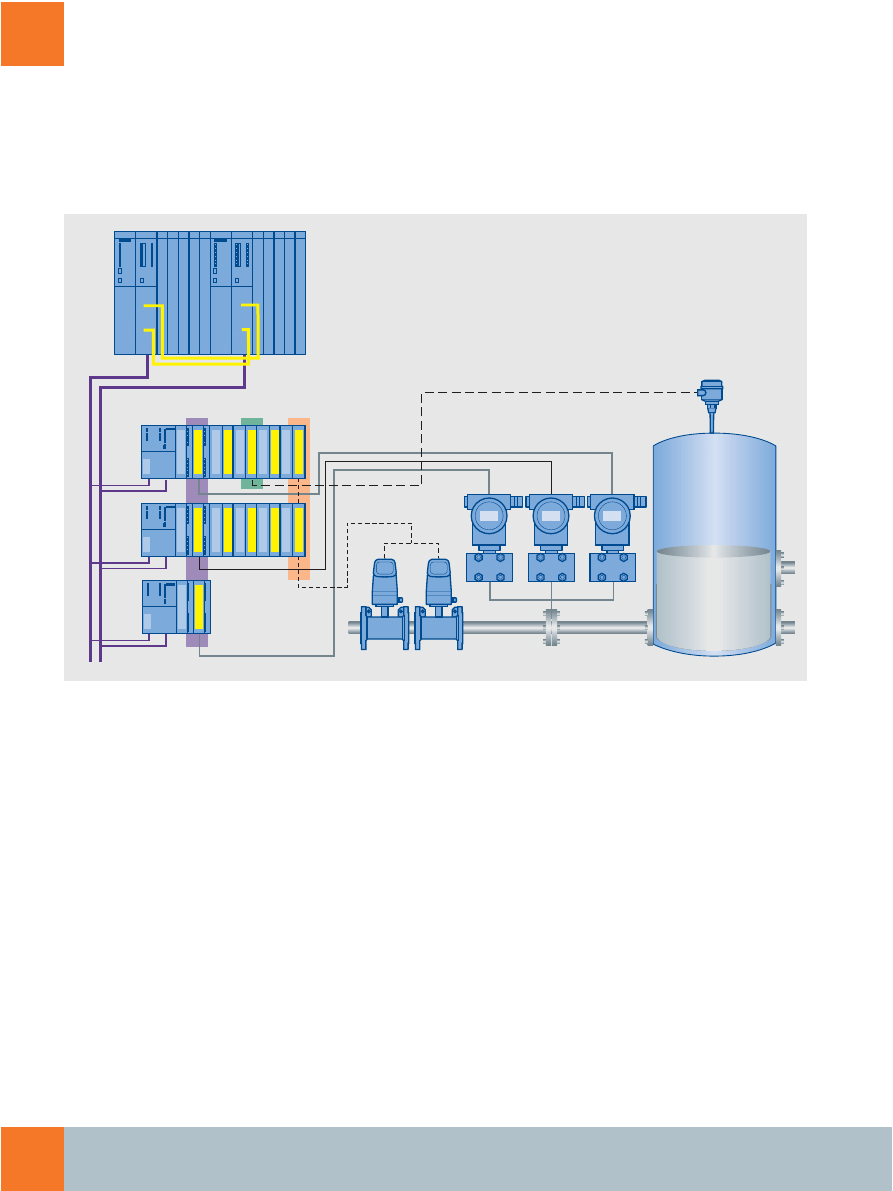
16
Flexible Modular Redundancy
Cost-optimized safety through flexible and
scalable fault tolerance
Flexible Modular Redundancy shown by an example of a safety-related, fault-tolerant plant configuration
An exceptional feature of Safety Integrated is the Flexible
Modular Redundancy (FMR). Depending on the automa-
tion task and safety requirements, this allows the config-
uring engineer to individually define the degree of redun-
dancy for the individual architecture levels comprising
controller, fieldbus and I/O, and to match it to the field in-
strumentation. Each component within a level can be pro-
vided with a redundant configuration, and also physically
separated. All components additionally comply with the
requirements of safety integrity level SIL 3.
You can then implement individual, fault-tolerant architec-
tures exactly tailored to the individual tasks which can tolerate
several simultaneously occurring faults. As shown in the
example of a plant with ET 200M distributed I/O system,
the overall system can accommodate a mixture of different
degrees of redundancy within an architecture level (1oo1,
1oo2, 2oo3).
Modeling of the reliability has shown that the Flexible Modu-
lar Redundancy from Siemens provides higher availability lev-
els than conventional redundant architectures with a uniform
double or triple structure. Since FMR only provides redundan-
cy where it is actually required, comparatively more attractive
and cost-effective safety applications are possible than with
conventional redundancy architectures.
Triple
Simplex
1oo1 LS
2oo3 PT
1oo2 Flow
Dual
S7-400FH controller
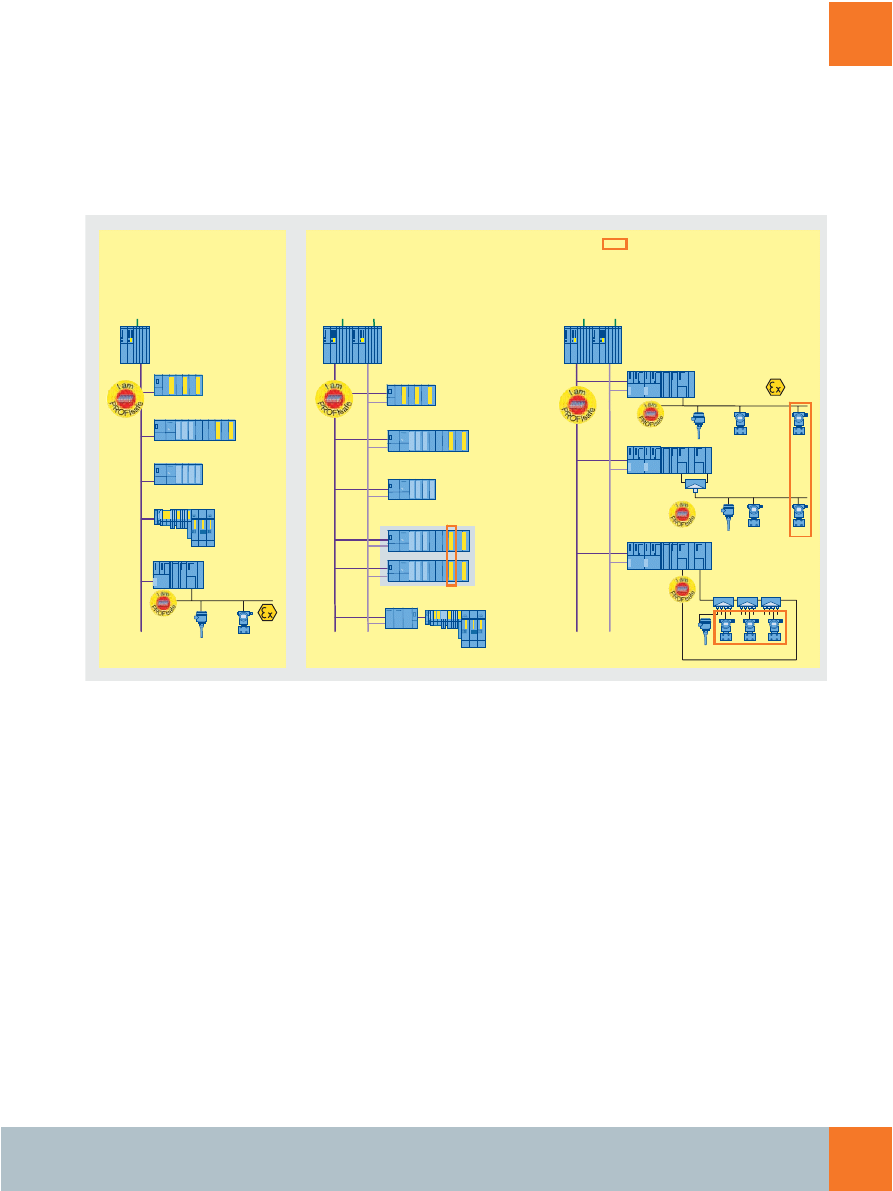
Flexible Modular Redundancy
17
Configuration options with FMR
Configuration options for safety-related systems shown by example of SIMATIC PCS 7 with S7-400H controllers
Within the overall FMR concept our Safety Instrumented
System configurations can be categorized into two distinct
options :
■
Single-channel, non-redundant configuration
■
Redundant, high-availability and fault-tolerant configuration
The two configuration options are extremely flexible, and
offer a wide design scope with respect to different customer
specific requirements. You can not only combine standard and
safety functions in the I/O area, also in the controller level you
are able to combine or separate standard control and safety.
The full range of flexibility and scalibility is possible with the
Flexible Modular Redundancy concept of Siemens.
In the individual architecture levels (controller, fieldbus, I/O)
you are offered the configuration alternatives shown in the
figure and in the following table depending on the I/O used
(remote ET 200M and ET 200S I/O stations or PROFIBUS PA
devices according to profile 3.0).
ET 200M
ET 200M
ET 200M
ET 200M
ET 200M
ET 200M
PROFIBUS PA
PROFIBUS PA
PROFIBUS PA
PROFIBUS PA
ET 200S
ET 200S
ET 200M
AS 412F/
AS 414F/
AS 417F
AS 412FH/
AS 414FH/
AS 417FH
AS 412FH/
AS 414FH/
AS 417FH
PROFIBUS DP
PROFIBUS DP
PROFIBUS DP
F-modules
F-modules
Active field
splitter
Active field distributors
F- and standard modules
F- and standard modules
Flexible Modular Redundancy
at module or device level
F- and standard modules
F- and
standard
modules
Standard modules
Standard modules
Module or channel
redundancy over
several separate
stations
DP/PA Link
DP/PA Link
with redundant
DP/PA couplers
DP/PA Link
with redundant
DP/PA couplers
PROFIBUS PA
DP/PA Link
Y-Link
Distributed I/O and
direct fieldbus interfacing
Direct fieldbus interfacing
Distributed I/O
Redundant, high-availability
and fault-tolerant configuration
Single-channel,
non-redundant configuration
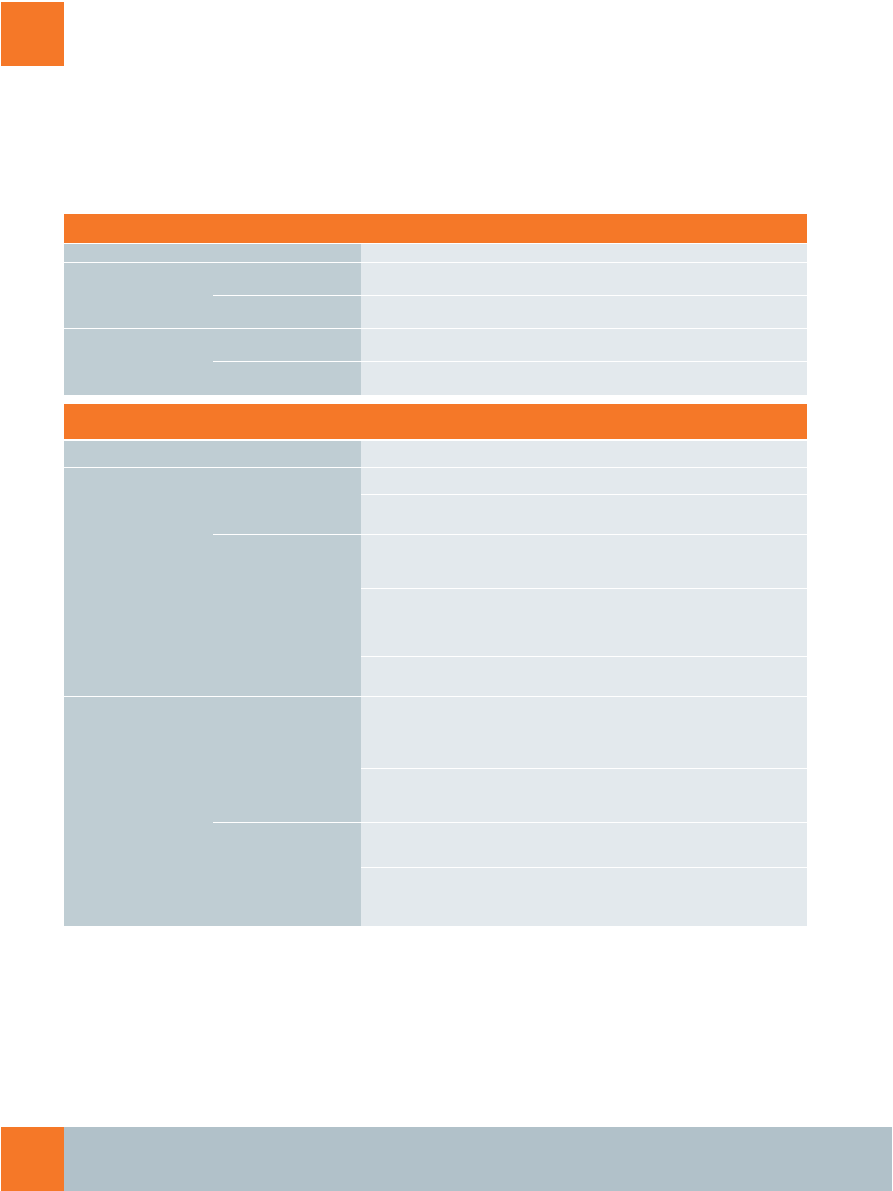
18
Flexible Modular Redundancy
Single-channel, non-redundant configuration
Controller
Single-channel, equipped with one CPU
Fieldbus
Distributed I/O (remote
I/Os)
Individual, single-channel PROFIBUS DP segment with PROFIsafe
Direct fieldbus interfacing
(PA devices)
Individual, single-channel PROFIBUS PA segment is connected to a single-channel
PROFIBUS DP segment over a simple router; PROFIsafe is included
Process I/O
Distributed I/O (remote
I/Os)
Remote ET 200 M and ET 200S I/O stations equipped uniformly with standard or
F-modules, as well as those with a mixed configuration on a PROFIBUS DP segment
Direct fieldbus interfacing
(PA devices)
Individual sensors/actuators on a PROFIBUS PA segment with a line or tree topology
Redundant and fault-tolerant configuration
Controller
High-availability and fault-tolerant, equipped with two redundant CPUs
Fieldbus
Distributed I/O (remote
I/Os)
Two redundant PROFIBUS DP segments with PROFIsafe
Two redundant PROFIBUS DP segments are reduced by a Y-Link to a single-channel
PROFIBUS DP segment; PROFIsafe is included
Direct fieldbus interfacing
(PA devices)
Individual, single-channel PROFIBUS PA segment (line/tree) is connected to two re-
dundant PROFIBUS DP segments over a single router; PROFIsafe is included; can be
used up to Zone 0 or 1
Individual, single-channel PROFIBUS PA segment (line) is connected to two redun-
dant PROFIBUS DP segments over an Active Field Splitter (AFS); PROFIsafe is includ-
ed. Automatic switching over of PROFIBUS PA segment to the respectively active
coupler of the redundant router per AFS; can be used up to Ex Zone 2
A PROFIBUS PA ring is connected to two redundant PROFIBUS DP segments over a
redundant router; PROFIsafe is included; can be used up to Ex Zone 2
Process I/O
Distributed I/O (remote
I/Os)
Remote ET 200M I/O stations equipped uniformly with standard or F-modules, and
those with a mixed configuration together on two redundant PROFIBUS segments
FMR is possible at the module or channel level using several, separate remote
I/O stations
Remote ET 200S I/O stations equipped uniformly with standard or F-modules, and
those with a mixed configuration on two redundant PROFIBUS segments via a Y-
Link
Direct fieldbus interfacing
(PA devices)
Individual sensors/actuators on a PROFIBUS PA segment with a line or tree topology
FMR possible through grouping of individual devices in different PROFIBUS PA segments
Individual sensor/actuators are integrated in a PROFIBUS PA ring with automatic bus
termination over up to 8 AFDs with 4 short-circuit-proof spur line connections
FMR possible through grouping of individual devices on different AFDs
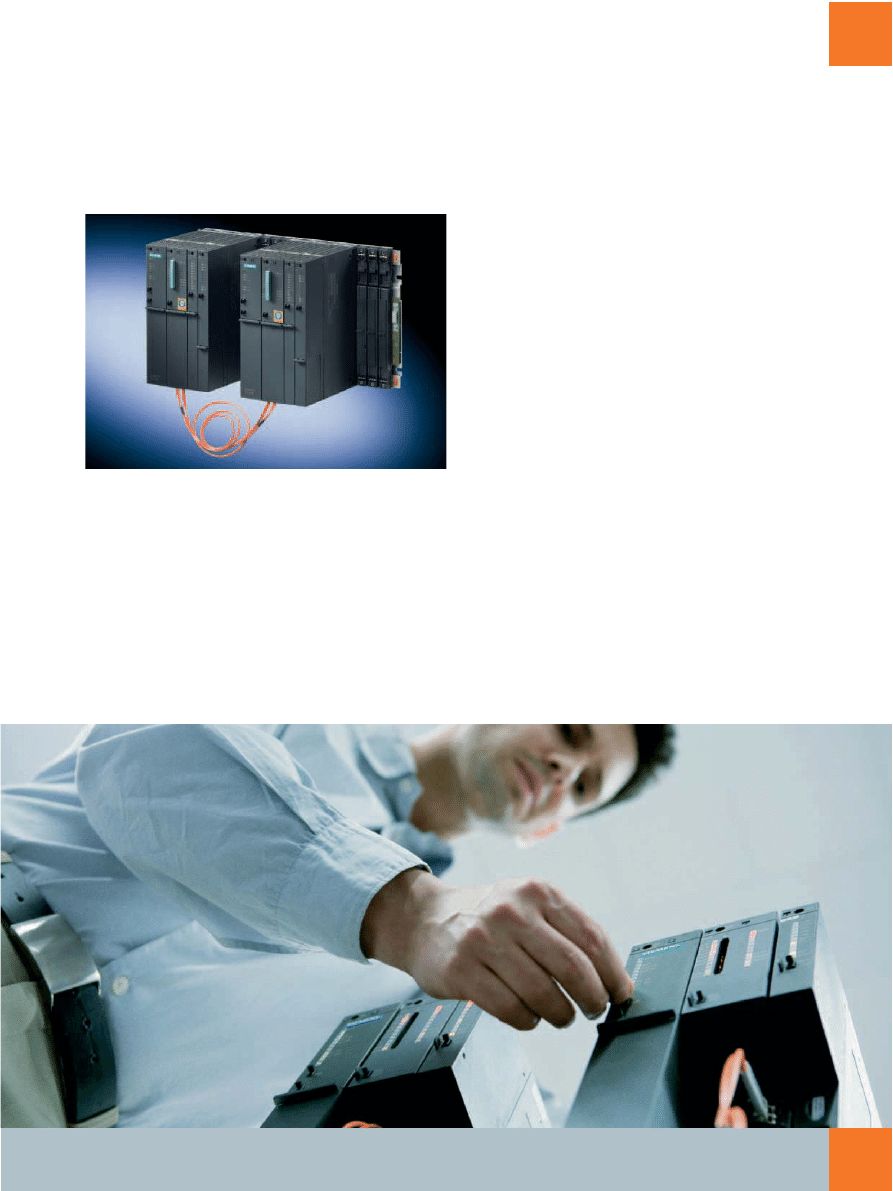
Flexible Modular Redundancy
19
SIMATIC controller for safety-related process applications
S7-417FH controller
Safety-related SIMATIC controllers are used for critical applica-
tions in which an incident can result in danger to persons,
plant damage or environmental damage. Working together
with the safety-related F-modules of the ET 200 distributed
I/O system or directly via fail-safe transmitters connected via
the fieldbus, they detect faults both in the process and their
own internal faults, and automatically set the plant to a safe
state in the event of a fault.
The SIMATIC S7-412FH, S7-414FH and S7-417FH controllers
are ideal for implementing safety-related process automation
applications. These are capable of multitasking, i.e. several
programs can be executed simultaneously in a CPU, whether
BPCS (standard) or safety-related applications. The programs
are functionally separate, i.e. faults in BPCS applications have
no effect on safety-related applications and vice versa.
Special tasks with very short response times can also be im-
plemented.
SIMATIC S7-300F controllers can also be used for smaller pro-
cess safety applications, e.g. burner controls. These control-
lers are otherwise primarily used in safety-related controls in
factory automation.
All controllers referred to are TÜV-certified and comply with
safety integrity levels up to SIL 3 according to IEC 61508. They
are able to process BPCS and safety functions in parallel in one
CPU. Mutual influencing during processing is prevented in
that the safety-related and BPCS program components remain
strictly separated and data exchange is executed by special
conversion blocks. The safety functions are executed twice
in different processor sections of one CPU through redundant,
multi-channel command processing. Potential errors are
detected by the system during the subsequent comparison
of results.
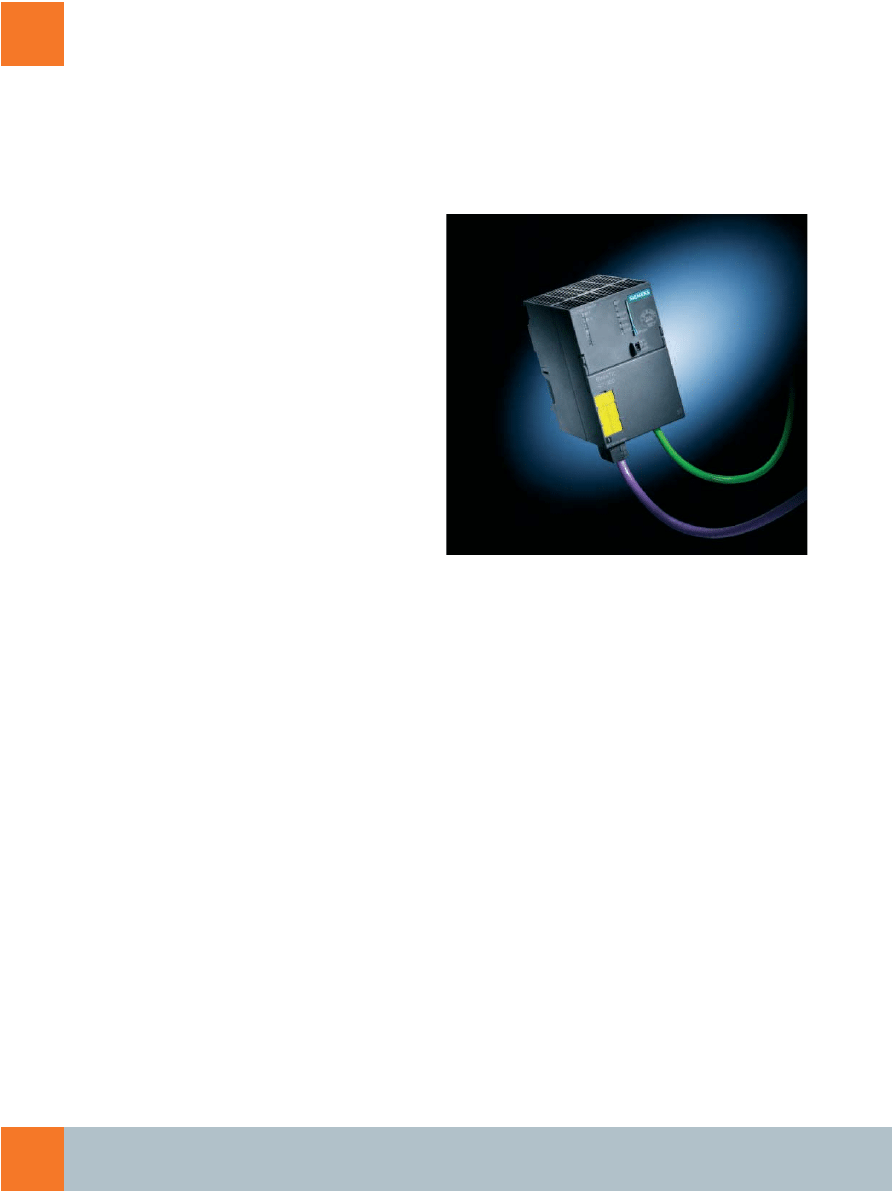
20
Flexible Modular Redundancy
S7-400FH and S7-300F controllers
S7-412FH, S7-414FH and S7-417FH controllers
The S7-412FH, S7-414FH and S7-417FH controllers are
based on the hardware of the S7-400H controllers. which is
extended by the safety functions in the S7 F Systems software
package. Single-channel (only one CPU) or fault-tolerant (two
redundant CPUs) operation is possible depending on the con-
figuration.
In the context of SIMATIC PCS 7, you can obtain the controllers
as preassembled and tested automation systems. These
product bundles usually include components such as racks,
CPU, power supply, main memory, memory card and
Industrial Ethernet interface.
They are available in two configuration versions with the
following product names:
■
Single-channel AS 412F, AS 414F or AS 417F
(with one CPU, safety-related)
■
High-availability AS 412FH, AS 414FH or AS 417FH
(with two redundant CPUs, safety-related and fault-toler-
ant)
The redundant FH systems working according to the 1-out-
of-2 principle comprise two subsystems of identical design. To
achieve optimum EMC, they are electrically isolated from one
another, and are synchronized over fiber-optic cables. In the
event of a fault, there is a bumpless switchover from the ac-
tive subsystem to the backup subsystem. The two subsystems
can be present in the same rack, or spatially separated by up
to 10 km. Spatial separation provides additional safety gains
in the case of extreme effects in the local environment of the
active subsystem, e.g. by fire.
The redundancy of the FH systems only serves to increase
availability. It is not relevant to processing of the safety func-
tions or the fault detection associated with this.
More information on the Internet:
www.siemens.com/fh-cpu
SIMATIC S7-300F controller
The SIMATIC S7-300F controllers have a very rugged and com-
pact design. They are only offered in a single-channel version
with one CPU. Fault-tolerant controllers with redundant CPUs
are not available in this series.
SIMATIC S7-300F controller
Through combination of the two CPU types S7-315F and
S7-317F with different fieldbus interfaces (DP or PN/DP),
the result is a product range with four controllers which is
rounded off at the top by the currently most powerful control-
ler S7-319F-3 PN/DP:
■
S7-315F-2 DP
■
S7-315F-2 PN/DP
■
S7-317F-2 DP
■
S7-317F-2 PN/DP
■
S7-319F-3 PN/DP
Controllers with S7-315F-2 DP or S7-317F-2 DP CPUs are
exclusively designed for fieldbus communication over
PROFIBUS DP.
Controllers with S7-315F-2 PN/DP, S7-317F-2 PN/DP or
S7-319F-3 PN/DP CPUs additionally support the PROFINET
standard, which has already become established in factory
automation.
You can expand the S7-300F CPUs centrally using the safety-
related F-modules of the ET 200M I/O system. Distributed ex-
pansion is possible with remote I/O stations and safety-related
F-modules of the ET 200M and ET 200S I/O systems.
More information on the Internet:
www.siemens.com/f-cpu
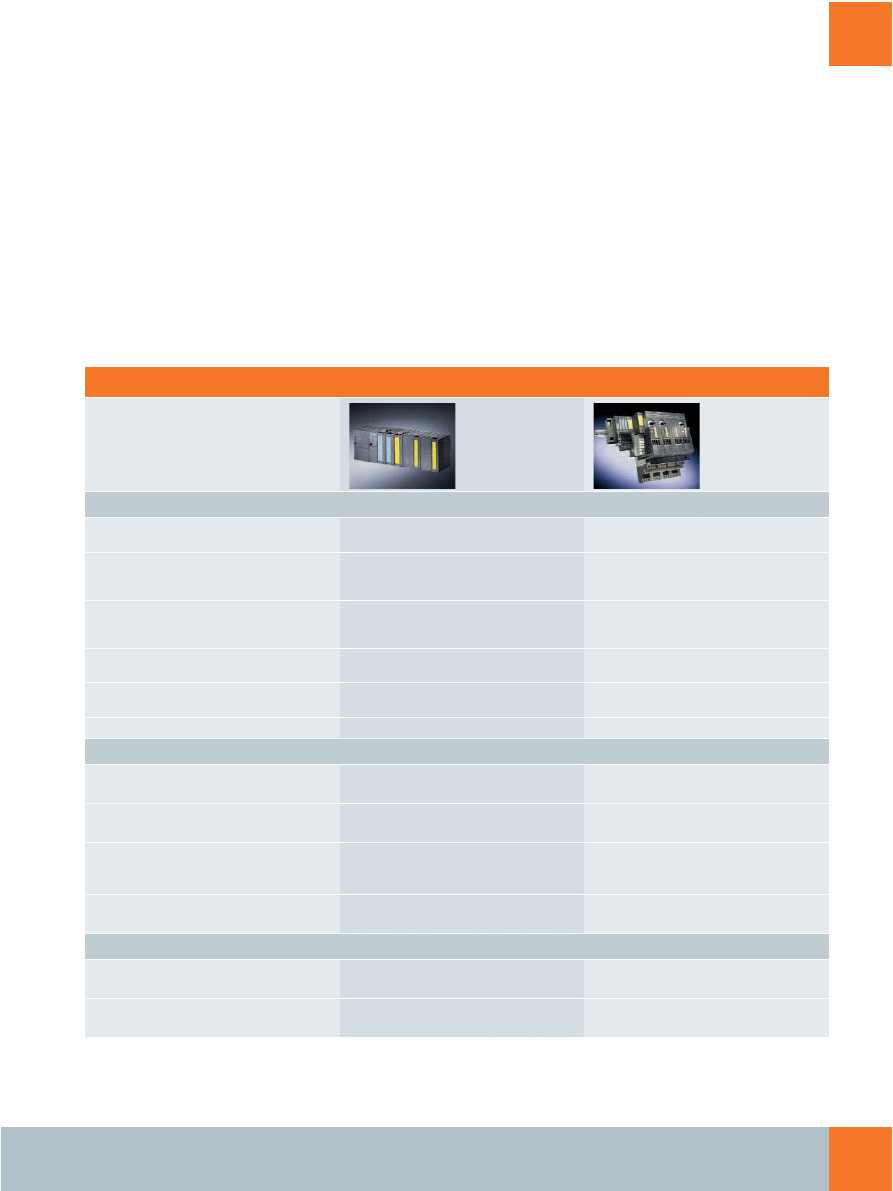
Flexible Modular Redundancy
21
Versatile, distributed I/O systems
The distributed I/O systems of the Safety Integrated System
can be differentiated as follows:
■
Modular ET 200M distributed I/O system with IP20 degree
of protection, the prime range of remote I/Os for process
automation with SIMATIC PCS 7
■
Bit-modular ET 200S distributed I/O system with indepen-
dent wiring and IP20 degree of protection
The safety functions of the SIMATIC controllers are perfectly
matched to the safety-related F-modules of these I/O systems.
Safety-related, distributed I/O systems
ET 200M
ET 200S
Device characteristics
For use in hazardous areas
Zones 2 and 22; connected sensors/actua-
tors also in Zones 1 and 21
Zones 2 and 22 (without motor starter)
Redundancy
■
PROFIBUS interface
■
Module channel (modules in separate
stations)
No
Online modification functions
■
Addition of station
■
Addition of I/O modules
■
Programming
■
Addition of station
Number of I/O modules
■
12 with IM 153-2 HF
■
8 with IM 153-2 HF FO (fiber-optic)
63
Mixing of standard and F modules
Station-by-station on the PROFIBUS as well
as within a station
Station-by-station on the PROFIBUS as well
as within a station
Time stamp functionality
Yes
No
F-modules
DI
12/24 x 24 V DC
4/8 x NAMUR [EEx ib]
4/8 x 24 V DC
DO
10 x 24 V DC/2 A
8x 24 V DC/2 A
4 x 24 V DC/2 A
AI
6 x 4...20 mA, 13 bits + sign
6 x 0 ... 20 mA or 4 … 20 mA HART,
15 bits + sign
--
Motor starters
--
F-DS1e-x
F-RS1e-x
PROFIBUS
Interface module
IM 153-2 HF
IM 153-2 HF FO (fiber optic)
IM 151-1 HF
Order No. stem
6ES7 153-2BA.
6ES7 153-2BB.
6ES7 151-1BA.
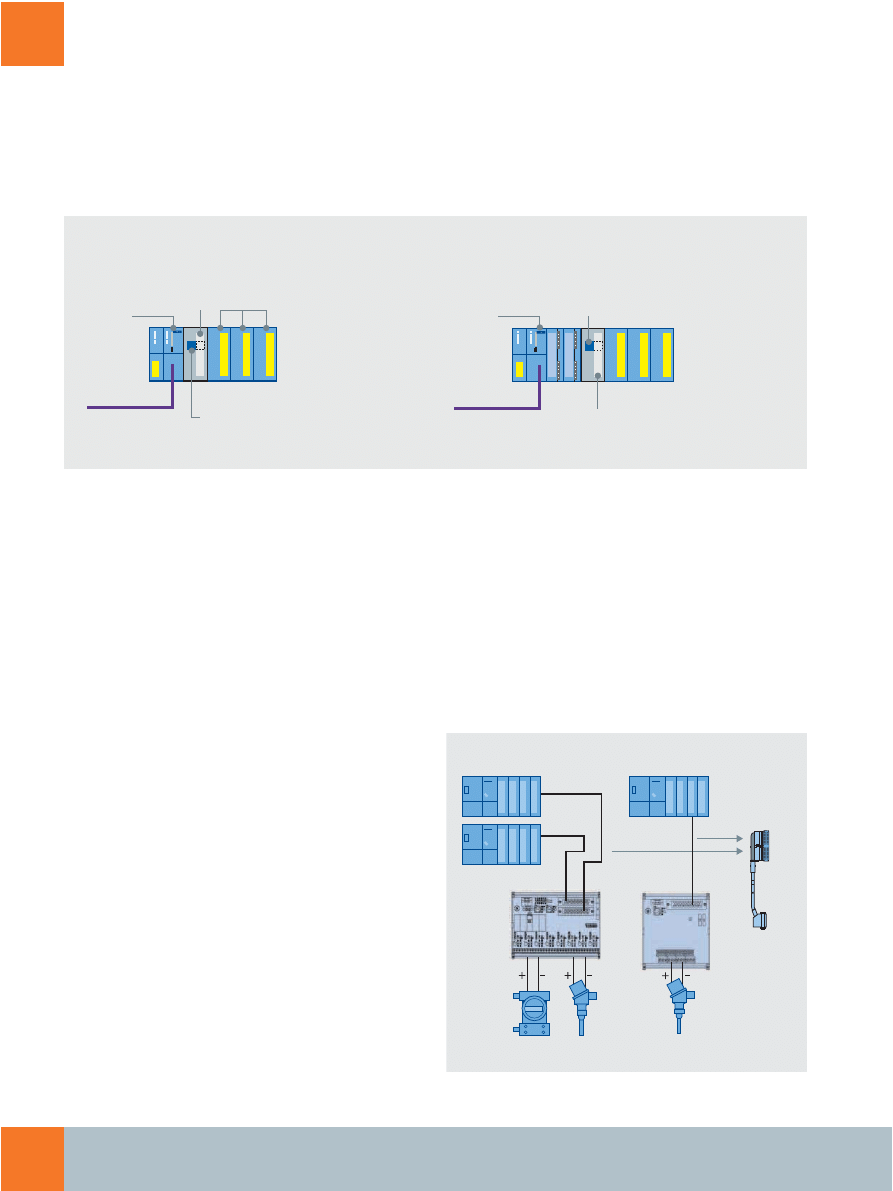
22
Flexible Modular Redundancy
ET 200M
ET 200M configuration
ET 200M configuration
An ET 200M station can accommodate up to 12 I/O modules
of S7-300 design. Hot swapping is permissible when using ac-
tive bus modules. The safety-related F-modules can be mixed
with standard modules within a station. In the case of applica-
tions according to SIL 3 and with mixed configurations with
standard modules, an isolating module is required on the left
of the F-modules. This protects the F-modules in the event of
overvoltages.
SIMATIC PCS 7 MTA terminal modules
Field devices, sensors and actuators can be connected simply,
rapidly and reliably to I/O modules of the ET 200M remote
I/O stations using SIMATIC PCS 7 MTA terminal modules
(Marshalled Termination Assemblies). MTA versions are avail-
able for standard I/O modules as well as for redundant and
safety-related I/O modules.
When using the MTAs, the requirements and costs for cabling
and commissioning are significantly reduced, and wiring er-
rors are avoided. They can of course be used with and without
SIMATIC PCS 7.
SIMATIC PCS 7 MTA terminal modules
IM 153-2
IM 153-2
F modules
ET 200 rack
Only for SIL 3 operation,
SIL 2 also possible
without isolation module
ET 200 rack
Design with F modules
Design with F and standard modules
Isolating bus module
for active
backplane bus
Isolating bus module
for active
backplane bus
Isolation module for isolation
of standard and F modules
PROFIBUS
Copper connection
PROFIBUS
Copper connection
or fiber-optic cable (FOC)
Isolation
module
Preassembled
cable with
front connector
ET 200M
redundant
ET 200M
single
MTA
MTA
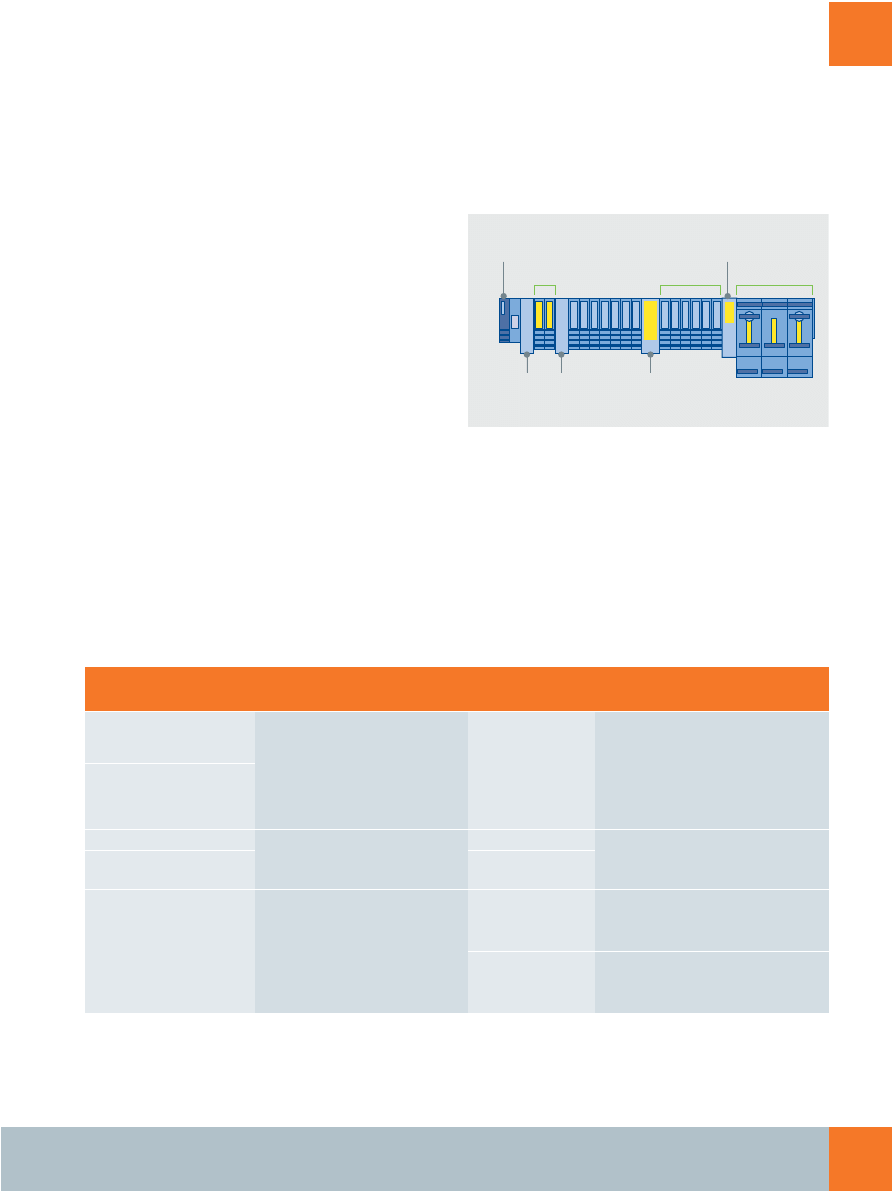
Flexible Modular Redundancy
23
ET 200S
ET 200S configuration
With an ET 200S station, up to 63 I/O modules (power mod-
ules, electronics modules, motor starters and expansion mod-
ules) can be inserted between the interface module and the
terminating module. Further configuration limits are the
width of up to 2 m, the max. address range of 244 bytes for
input data and the same for output data, as well as the limit-
ing of parameters to a maximum of 244 bytes per station.
Power modules are suitable for configuring the I/O modules in
potential groups. A power module together with its following
I/O modules constitute a potential group in each case, whose
scope is limited by the current carrying capacity of the power
module (up to 10 A depending on the type). The power mod-
ule handles the monitoring and also - depending on the ver-
sion - the fusing of the power supply for this potential group.
The first power module must be positioned directly following
the interface module.
ET 200S configuration
Which power module (PM) is used in each case depends on the
application and the I/O modules used in it. The power modules
listed in the table are relevant to safety-related applications.
An ET 200S station can be configured rapidly and simply using
the SIMATIC ET 200 Configurator. This is acquainted with the
configuration rules, and provides interactive support for selec-
tion of all components and the matching accessories. The
SIMATIC ET 200 Configurator is available on the Internet at:
www.siemens.com/et200
1)
Only AK4/SIL 2 can be achieved when mixing standard and F modules within a potential group.
SIL 3
SIL 2
SIL 3
PM-E
power module
PM-E F
power module
PM-D F
PROFIsafe
IM 151
High Feature
Fail-safe
motor starter
Power module
Use
Achievable safety
(AK/SIL)
Appropriate
I/O modules
PM-E F pm DC 24 V PROFIsafe
(pm for earth-free loads;
ground and earth separated)
Safe shutdown of subsequent stan-
dard DO modules 24 V DC
AK4/SIL 2
All non-safety-related standard electronics
modules 24 V DC
PM-E F pp DC 24 V PROFIsafe
(pp for grounded loads;
ground and earth connected
together)
PM-E DC 24 V
Supply of F-DI modules and F-DO
modules
AK4/SIL 2
All electronics modules (safety-related
and standard modules) in the respective
voltage range
PM-E
DC 24 ... 48 V/AC 24 ... 230 V
AK6/SIL 3
1)
PM-D F DC 24 PROFIsafe
Safe shutdown of F-motor starters
AK6/SIL 3
■
Safety-related (F) motor starters
F-DS1e-x and F-RS1e-x with or without
Brake Control xB1 and xB2 expansion
modules
AK4/SIL 2
■
Safety-related (F) motor starters
F-DS1e-x and F-RS1e-x with or without
Brake Control xB3 and xB4 expansion
modules
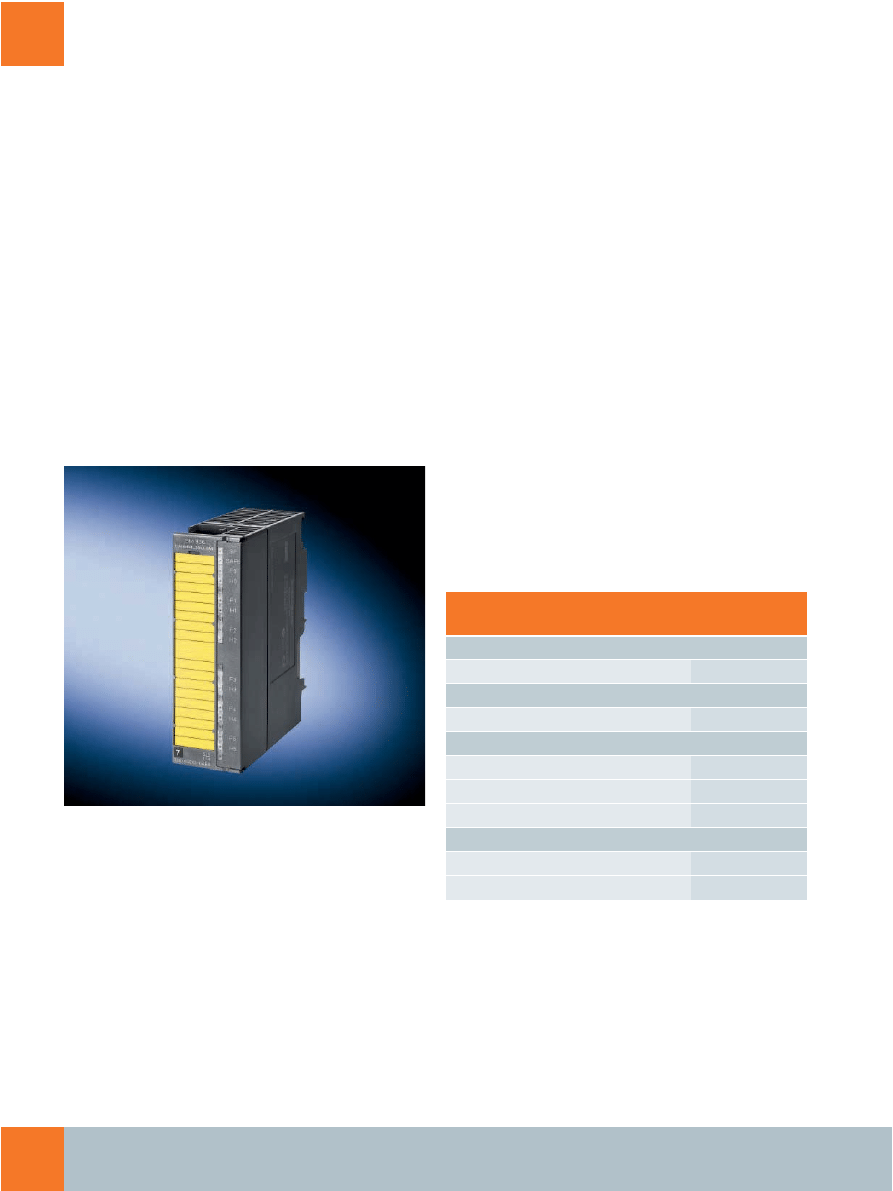
24
Flexible Modular Redundancy
F-modules
The F-signal modules of ET 200M and ET 200S (DI/DO/AI) can
be used for diagnostics of both internal and external faults.
They carry out self-tests, e.g. for short-circuit or open-circuit,
and automatically monitor the discrepancy time defined in
the parameter settings.
Depending on the version, the input modules support 1oo1
and 2oo2 evaluation on the module. Further evaluations, e.g.
2oo3 evaluation for analog inputs, are carried out by the CPU.
The digital output modules enable safe disconnection
through a second disconnect path in the event of a faulty out-
put.
F-AI HART analog input module for ET 200M (6 x 0/4 ... 20 mA)
F-AI HART analog input module for ET 200M
The F-AI HART analog input module with 6 inputs for current
measurements in the range from 0 to 20 mA or 4 to 20 mA is
the first safety-related ET 200M module with the compact
width of 40 mm. All 6 channels of the module are designed for
SIL 3. When using F-AI HART modules instead of older F-AI
modules with twice the width, the achievable packing density
is four times as high.
The module is also suitable for HART communication with
HART field devices. The HART communication can be switched
off safety-related.
The function example "F Systems: Wiring and Voting Architec-
tures for ET 200M F-AIs" on the Internet shows wiring and
evaluation architectures for safety-related analog signals. See
www.siemens.com/process-functional-examples
F-motor starters
Initiated by a switch-off signal, safety-related ET 200S motor
starters can be selectively switched off by the series-connect-
ed PM-D F PROFIsafe power module. In addition to a circuit-
breaker/contactor combination, the fail-safe ET 200S motor
starters have a safe electronic evaluation circuit for fault de-
tection. If the contactor to be switched in the case of an emer-
gency stop fails, the evaluation electronics detects a fault and
deactivates the circuit-breaker in the motor starter in a safety-
related manner.
Safe process instruments and process devices for
connection to ET200 remote I/Os:
Siemens currently offers the following safe process instru-
ments/devices for operation on ET 200M remote I/Os:
Detailed information, technical specifications and ordering
data on these devices are available on the Internet at:
www.siemens.com/fielddevices
Process instrument/
process device
Safety Integrity
Level (SIL)
Pressure measurement
SITRANS P DS III analog/HART
SIL 2
Temperature measurement
SITRANS TW series
SIL 1
Level measurement
Pointek CLS 200 analog
SIL 2
Pointek CLS 300 analog
SIL 2
Pointek ULS 200
SIL 1
Position control
SIPART PS2, two-wire version
SIL 2
SIPART PS2, four-wire version
SIL 2
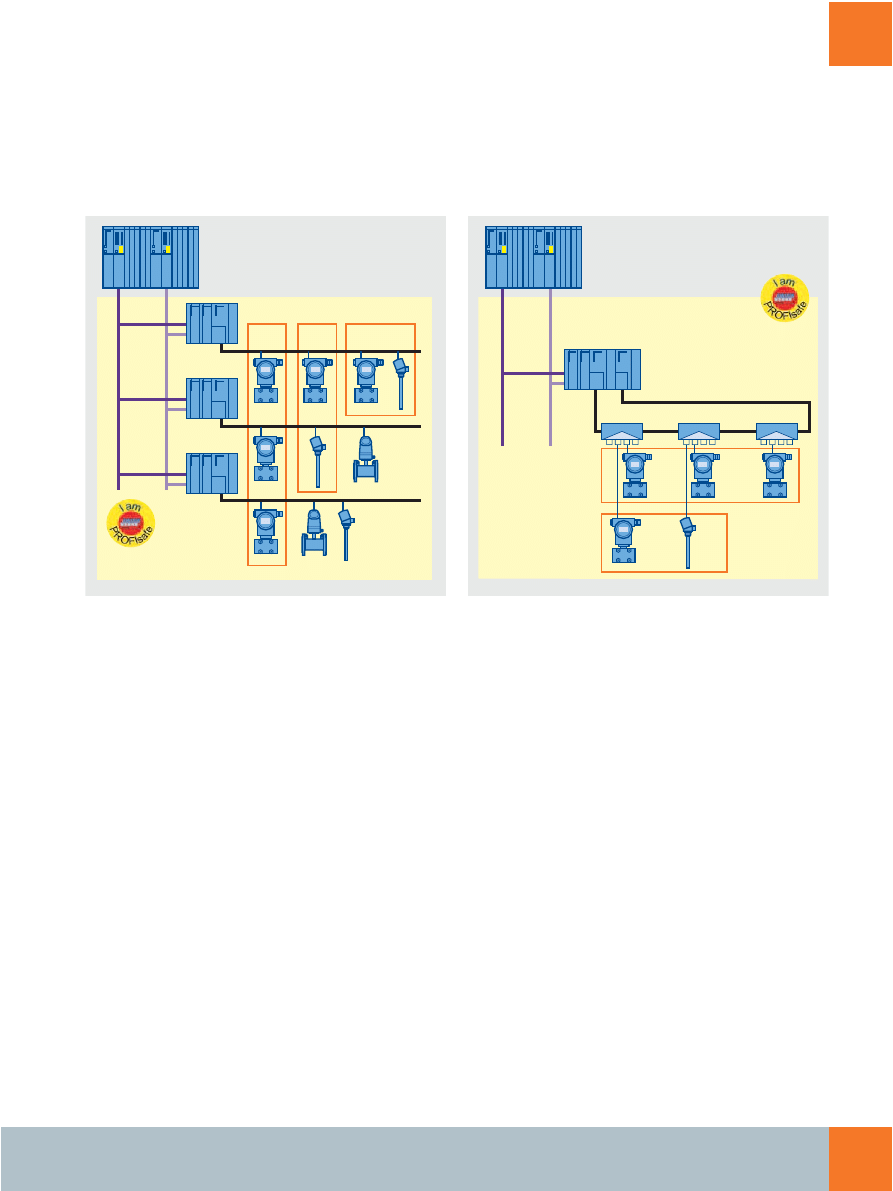
Flexible Modular Redundancy
25
Direct device interfacing via fieldbus
with high safety and availability
Example of previously standard safety-related and fault-tolerant PROFIBUS PA
configurations
For plant areas up to hazardous Zone 2, redundant routers to-
gether with a PROFIBUS PA of ring topology permit cheaper
safety-related and fault-tolerant applications than the previ-
ous standard architectures (see figure at top left).
The PROFIBUS PA of ring topology is connected to two redun-
dant PROFIBUS segments of an S7-400FH controller via the re-
dundant router. Each of the maximum 8 Active Field Distribu-
tors (AFD) in this PROFIBUS PA ring with automatic bus termi-
nation has 4 short-circuit-proof spur lines for connection to
devices.
Safety-related and fault-tolerant architecture based on a PROFIBUS PA ring to-
pology
As shown in the figure on the right, safety-related and fault-
tolerant applications can be implemented with relatively low
device and cable requirements. The configuration of the ring
can also be changed during runtime. Even brief opening-up of
the ring in order to integrate a further AFD is possible without
production failures. The diagnostics integrated in the redun-
dant router and the AFDs expands the existing possibilities for
communication and cable diagnostics, and makes fault locat-
ing easier in the event of an open-circuit.
The concept of Flexible Modular Redundancy is thus imple-
mented down to the field level.
PROFIBUS DP
2oo3 1oo2 1oo2
S7-400FH controller
DP/PA Link
PROFIBUS DP
2oo3
1oo2
AFD
AFD
AFD
S7-400FH controller
DP/PA Link
with redundant DP/PA couplers
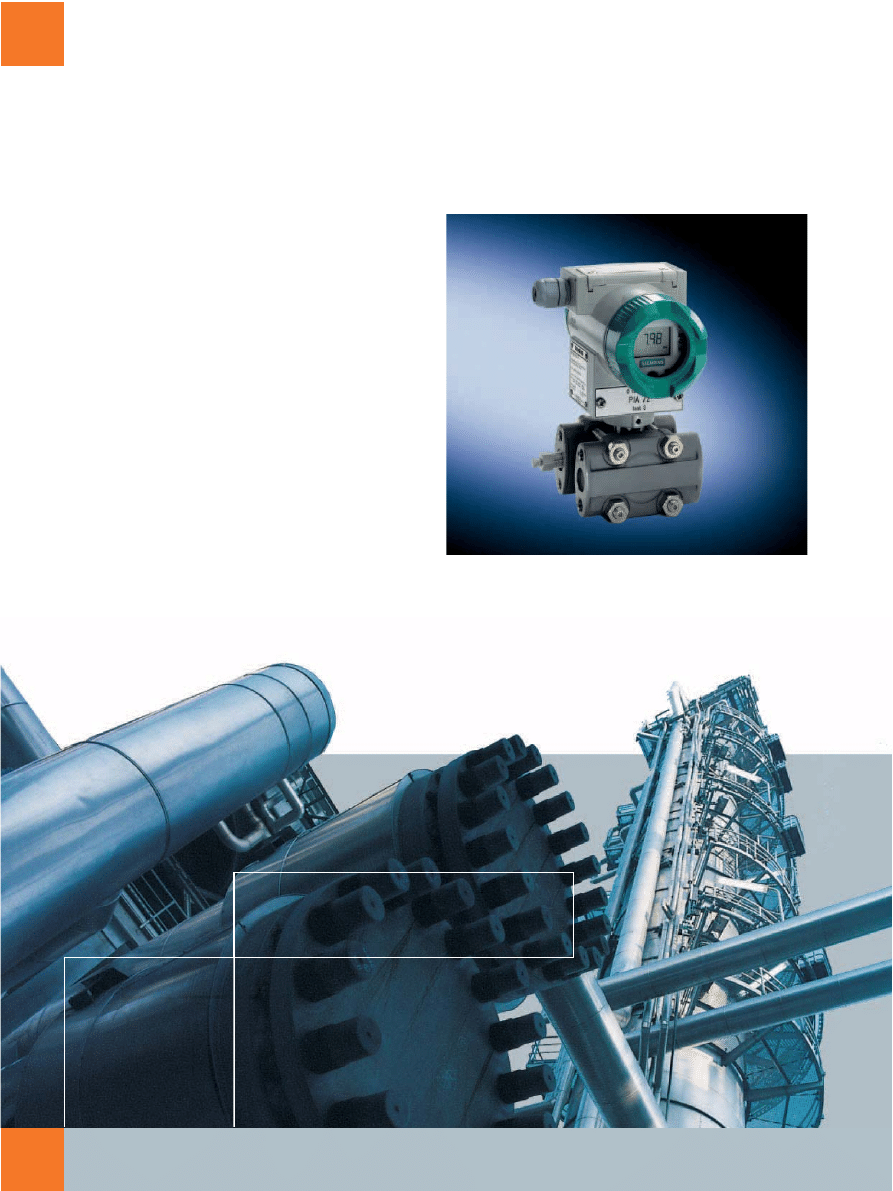
26
Flexible Modular Redundancy
Safe field instrumentation on the PROFIBUS PA
PROFIBUS PA devices for implementation of safety
shutdowns
The SITRANS P DSIII digital pressure transmitter is the first
PROFIBUS PA device available on the market for SIL 2 safety
shutdowns according to IEC 61508/ IEC 61511-1. To this end,
Siemens has extended its standard measuring equipment for
pressure, absolute pressure and differential pressure by a
PROFIsafe driver.
In a safety application, the pressure transmitter can be con-
nected to an FH controller from the SIMATIC S7-400 series
over PROFIBUS PA including PROFIsafe. Advantages such as
direct communication links and power supply to intrinsically-
safe devices, increased information contents and integrity of
measured-value transmission are then combined with each
other. The digital input of the electropneumatic PROFIBUS PA
positioner SIPART PS2 PA can be used for the safe shutdown.
With a redundant, multi-channel design, measuring circuits
can also be implemented up to safety integrity level SIL 3.
The SIMATIC PDM Process Device Manager is used to initially
start up the SITRANS P DSIII pressure transmitter as a regular
PROFIBUS PA device. You subsequently activate the PROFIsafe
functions.
SITRANS P DSIII PROFIsafe pressure transmitter
The device description (DD) required for this, the safety
manual as well as further information are available on
the Internet at:
www.siemens.com/sitransp
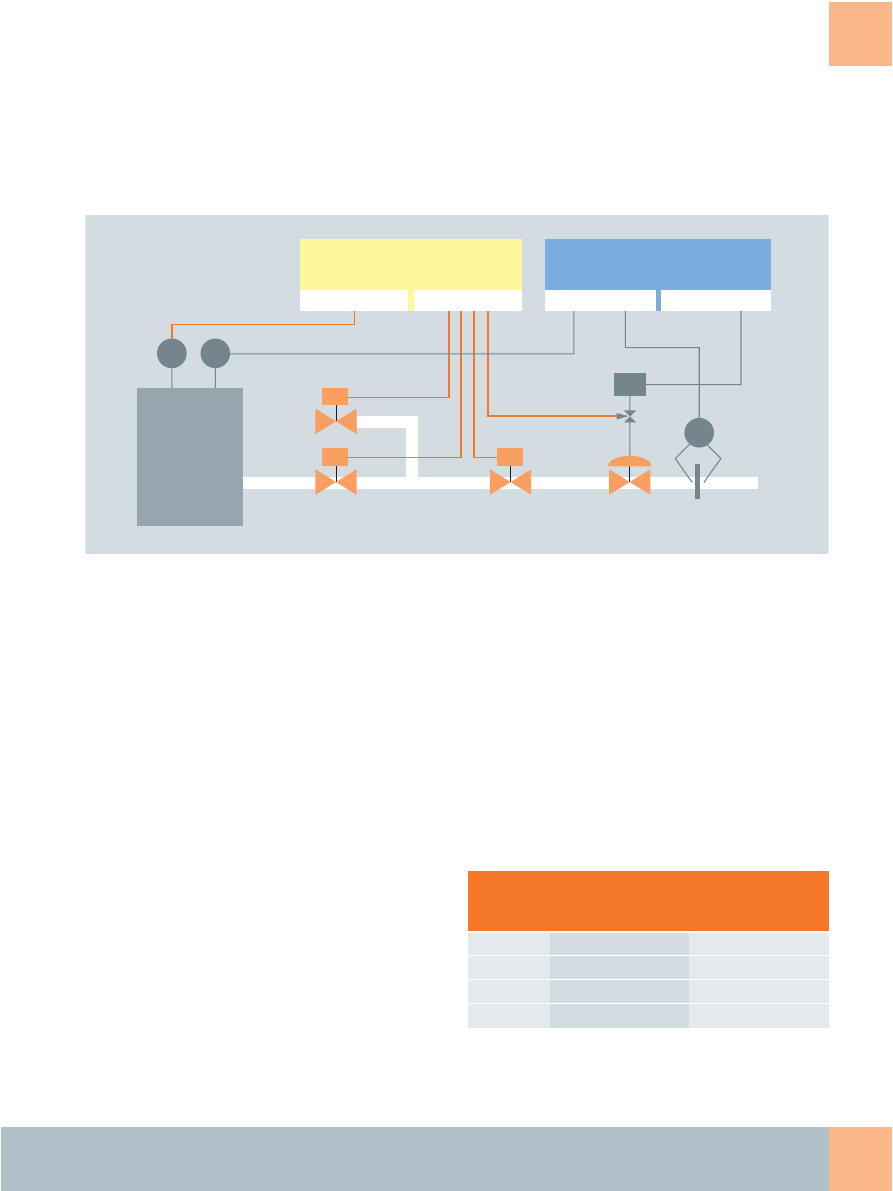
Safety Lifecycle Management
27
Analysis phase
Safety Instrumented Function (SIF) in the SIS
The safety lifecycle is divided into three phases according to
IEC 61511: analysis, implementation and operation/mainte-
nance.
Safety lifecycle management always commences in that the
process concept, the functional safety management plan and
the historical recordings are examined in order to determine
known or potential safety risks.
In a second step, the results are subject to a risk analysis. The
objective is to filter out the non-tolerable risks, to rate the
probability for the occurrence of a hazard, and to estimate the
possible consequences. Various methods are available to this
end, e.g.:
■
HAZOP
■
Danger tree analysis
■
Checklists
■
FMEA (Failure Modes and Effects Analysis)
Various tools available on the market effectively support the
risk analysis through automation of the described procedures.
The result of the risk analysis is documented in the safety re-
quirements specification. This is the basis for subsequent
plant planning.
The probability of a safety-relevant event and its effects can
be reduced by appropriate protection measures (LOPA, Layer
of Protection).
A possible protective measure is the use of a Safety Instru-
mented System (SIS). The SIS is an independent safety system
comprising components ranging from sensor over controller
to final elements. It is suitable for the following purposes:
■
Shutdown: a process or plant is automatically driven to a
safe state when a predefined condition is violated.
■
Tolerance: under defined conditions, the plant can still be
operated safely.
■
Reduction: possible consequences of a safety event are
minimized and thus limited.
The SIL describes the measures for risk reduction. The
achievable risk reduction factor will increase with higher
SIL level.
1)
Low demand mode of operation
PT
1A
PT
1B
I/P
FT
Safety Instrumented System
(SIS)
Reactor
Inputs
Outputs
Inputs
Outputs
Basic Process Control System
(BPCS)
Safety
Integrity
Level
Probability of failure
on demand (PFD) per
year
1)
Risk
Reduction
Factor
SIL 4
≥ 10
-5
to < 10
-4
10,000 to 100,000
SIL 3
≥ 10
-4
to < 10
-3
1,000 to 10,000
SIL 2
≥ 10
-3
to < 10
-2
100 to 1,000
SIL 1
≥ 10
-2
to < 10
-1
10 to 100
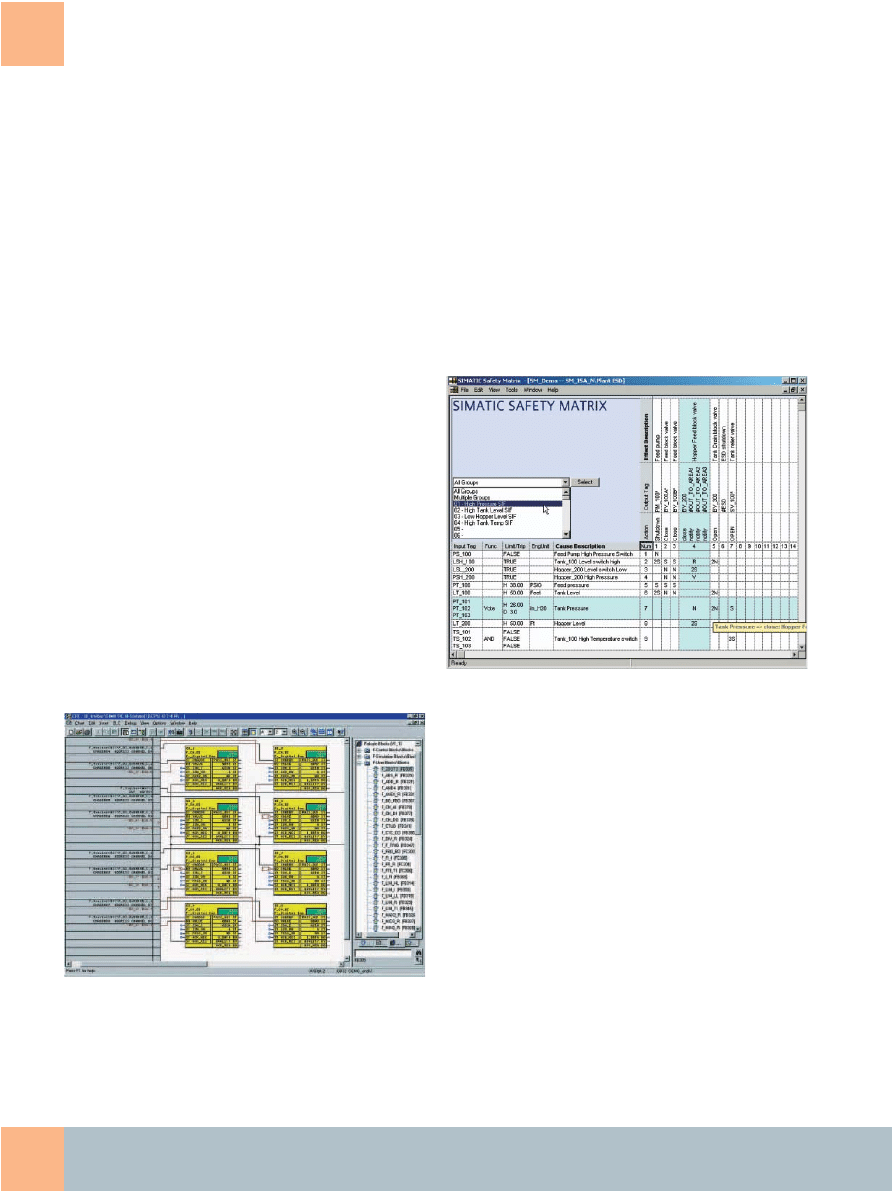
28
Safety Lifecycle Management
Realization phase
The realization phase is characterized by selection of the tech-
nology and architecture, definition of the proof test interval,
the design and installation of the SIS, as well as commission-
ing.
Siemens provides the F-block library in S7 F Systems and the
SIMATIC Safety Matrix for configuration and programming of
the S7-400FH controllers.
S7 F Systems with F-block library and Safety Matrix
The S7 F Systems engineering tool permits parameterization
of the S7-400FH systems and the safety-related F-modules
from the ET 200 series.
It supports configuration by means of functions for:
■
Comparison of safety-related F-programs
■
Recognition of changes in the F-program using the
checksum
■
Separation of safety-related and standard functions.
Access to the F-functions can be password-protected. The
F-block library integrated in S7 F Systems contains predefined
function blocks for generation of safety-related applications
with the CFC or the SIMATIC Safety Matrix based on it. The cer-
tified F-blocks are extremely robust and intercept program-
ming errors such as division by zero or out-of-range values.
The diverse programming technique is then used for detect-
ing and reacting to any further errors.
Engineering of safety-related applications using CFC
SIMATIC Safety Matrix
The SIMATIC Safety Matrix which can be used in addition to
CFC is an innovative safety lifecycle tool from Siemens which
can be used for convenient configuration of safety applica-
tions and also for their operation and maintenance. Based
on the proven principle of a Cause&Effect matrix, the tool is
highly suitable for processes where defined statuses require
specific safety reactions.
Safety Matrix: assignment of exactly defined reactions (effects) to occurring
events (causes)
The SIMATIC Safety Matrix not only means that programming
of the safety logic is significantly simpler and more conve-
nient, but also much faster than in the conventional manner.
During the risk analysis of a plant, the configuration engineer
can assign exactly defined reactions (effects) to events
(causes) which may occur during a process.
The possible process events (inputs) are initially entered in the
horizontal lines of a matrix table comparable to a spreadsheet
program, and then their type and quantity, logic operations,
any delays and interlocks as well as any tolerable faults are
configured. The reactions (outputs) to a particular event are
then defined in the vertical columns.
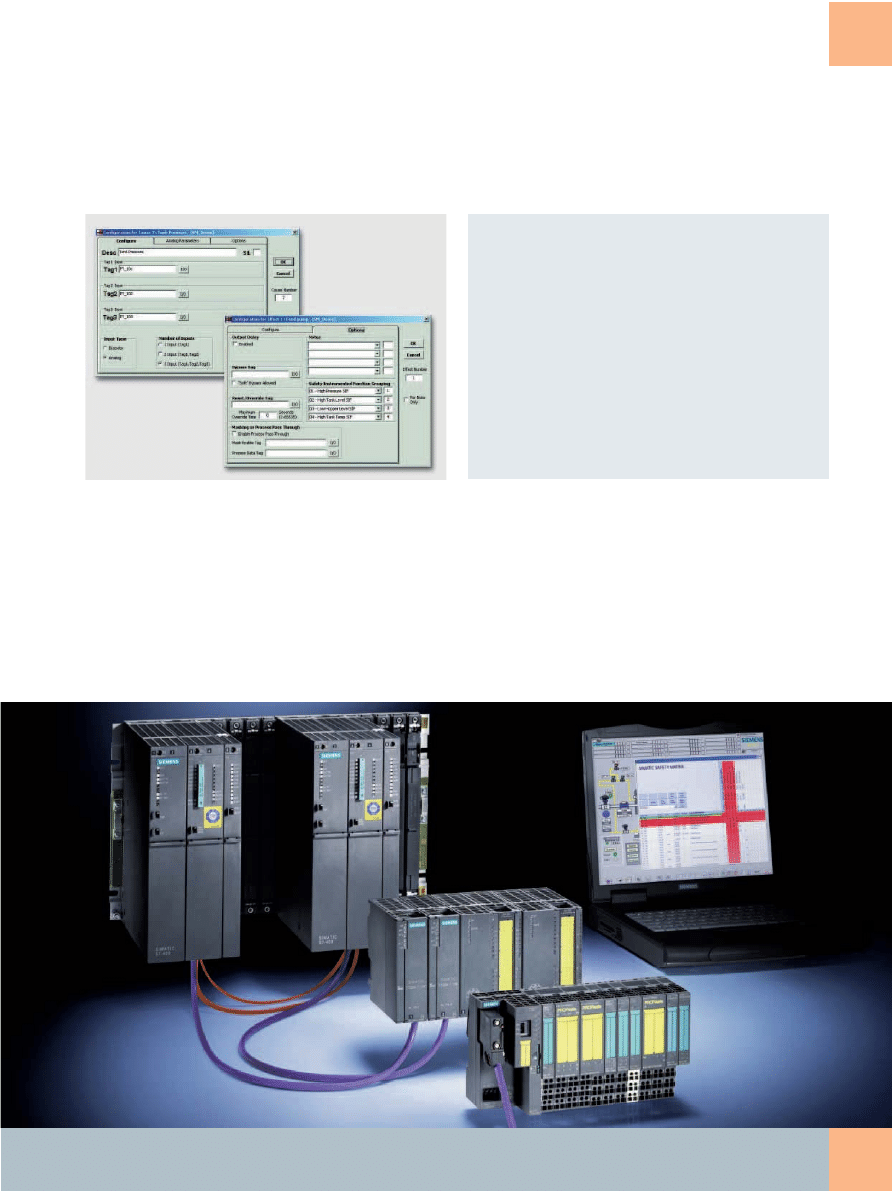
Safety Lifecycle Management
29
Input window for configuration of analog or digital causes as well as their
digital effects
The events and reactions are linked by simply clicking the
cell at the intersection point of line and column. Using this
procedure, the Safety Matrix automatically generates com-
plex, safety-related CFC programs. Configuration engineers
require no special programming knowledge, and can concen-
trate fully on the safety requirements of their plants.
Advantages of the Safety Matrix in the
realization phase
■
Simple programming using Cause&Effect method
■
No programming knowledge required
■
Automatic generation of CFCs including driver blocks
■
Automatic version tracking
■
Integral tracking of changes
■
1-to-1 printout of Cause&Effect matrix
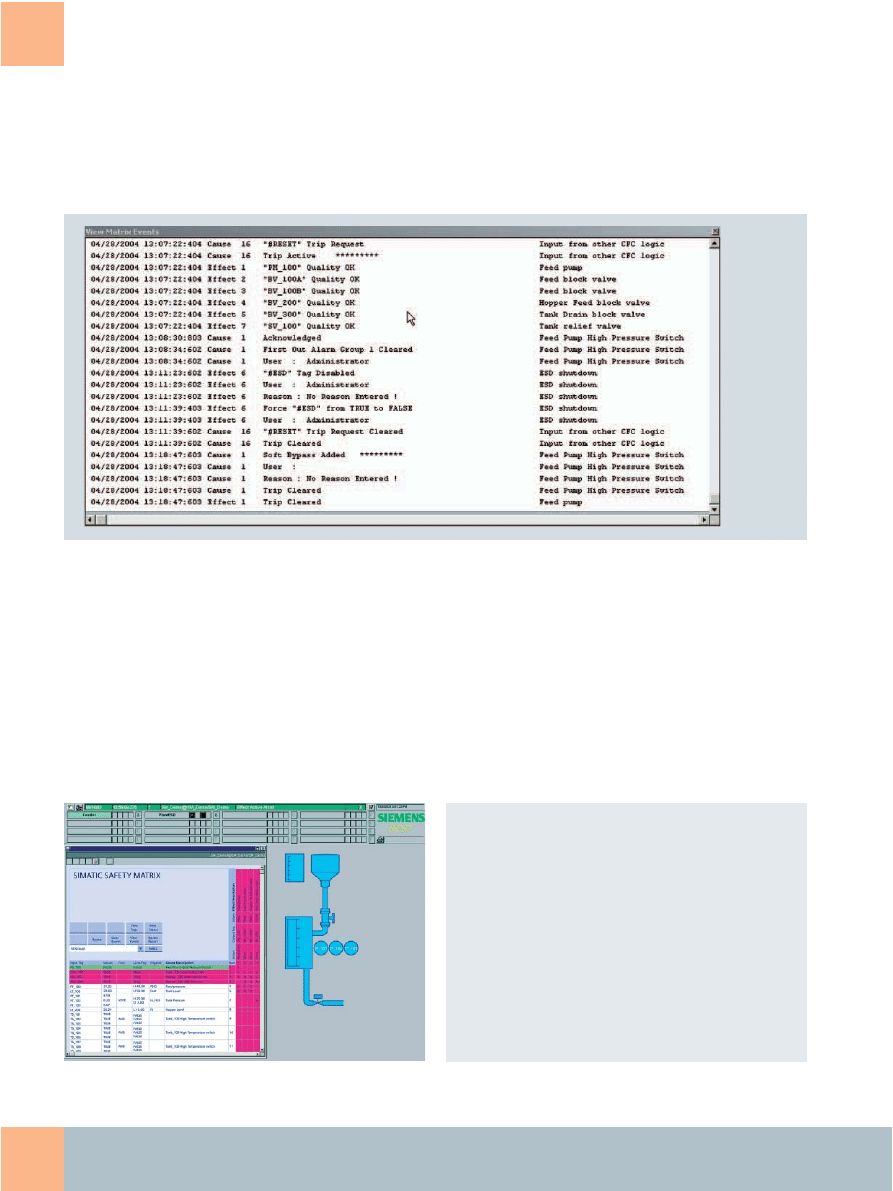
30
Safety Lifecycle Management
Operation and maintenance phase
Documentation of changes with the Safety Matrix
The third and final phase of the safety lifecycle comprises
operation, maintenance and modification of the safety appli-
cation as well as plant decommissioning.
The Viewer of the SIMATIC Safety Matrix which can be used on
the SIMATIC PCS 7 operator station permits simple and intui-
tive operation and monitoring of the safety application during
runtime. The signal status is displayed online in the
Cause&Effect matrix.
Viewer of the Safety Matrix on a SIMATIC PCS 7 operator station
The operator can display and save first-up signals and also
record safety-relevant events. Changes in parameters are sup-
ported, as are bypass, reset and override functions.
Safety lifecycle management functions for version manage-
ment and for documentation of operator interventions and
program modifications effectively supplement the configura-
tion, operation and servicing functions of the SIMATIC Safety
Matrix and also the safety lifecycle management.
Advantages of the Safety Matrix in the operation phase
■
Complete integration in SIMATIC PCS 7
■
First-up alarm display and saving
■
Integral operating functions such as bypass, reset,
override and parameter modification
■
Sequence of event display and saving
■
Automatic saving of operator interventions for the
safety lifecycle management
■
Automatic version tracking
■
Automatic documentation of modifications
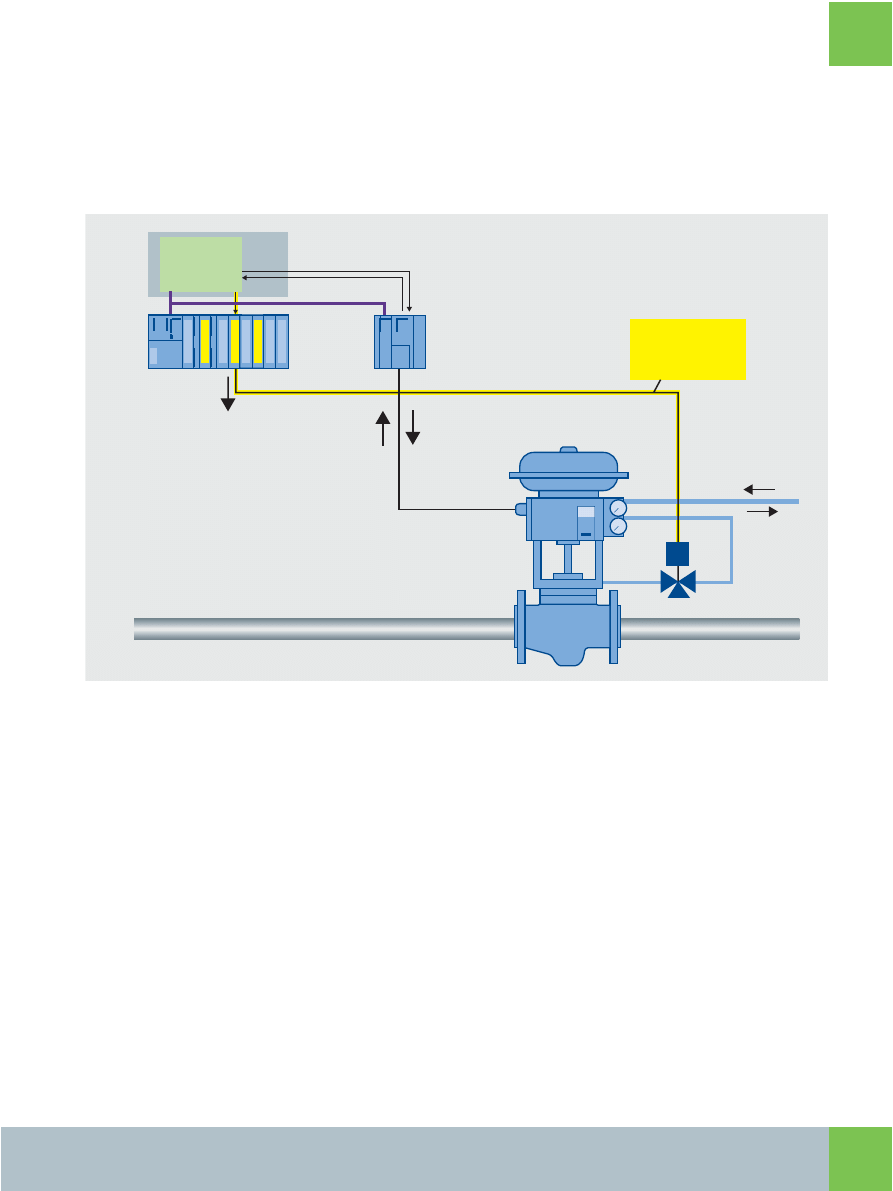
Application examples
31
Partial Stroke Test (PST)
Configuration example for the Partial Stroke Test
In order to guarantee that emergency shutdown (ESD) valves
of a Safety Instrumented Function (SIF) also operate fault-free
when a safety event occurs, their functionality must be regu-
larly checked.
With a plant shutdown, this can be carried out using a Full
Stroke Test. However, since the valve is completely closed dur-
ing this procedure, the test method cannot usually be used
during process operation.
The Partial Stroke Test is an excellent alternative in this case.
During this test, the valve motion is checked by partially open-
ing or closing it without stopping the process. The valve stroke
is usually 10 to 15%. The length of the partial stroke depends
on the process conditions and the required degree of cover-
age of the diagnostics function.
By means of Partial Stroke Tests, the time interval between
the required Full Stroke Tests can be extended without
changing the SIL. When carrying out these tests regularly (e.g.
4 times a year), the interval between two Full Stroke Tests
could be extended from one year to two.
The Safety Instrumented System from Siemens already con-
tains preconfigured function blocks for automatic execution
of the Partial Stroke Test at the defined test intervals. These
provide operator alarms and feedbacks on the valve function,
and apply PFD calculations (Probability of Failure on Demand)
to determine the time of the next Full Stroke Test.
Ready-to-use faceplates are available for visualization on the
operator system. These permit a fast overview of the valve
state and the PST parameters, indicate the status of the last
Partial Stroke Test, and inform of further planned tests.
S
ET 200M
SIS controller
DP/PA coupler
Pneumatic shutdown valve
Safety
application
F-AI
F-DO
Safety
Instrumented
Function
Solenoid valve
Air supply
Setpoint for
valve position
Feedback of
valve position
SIPART PS2
valve positioner
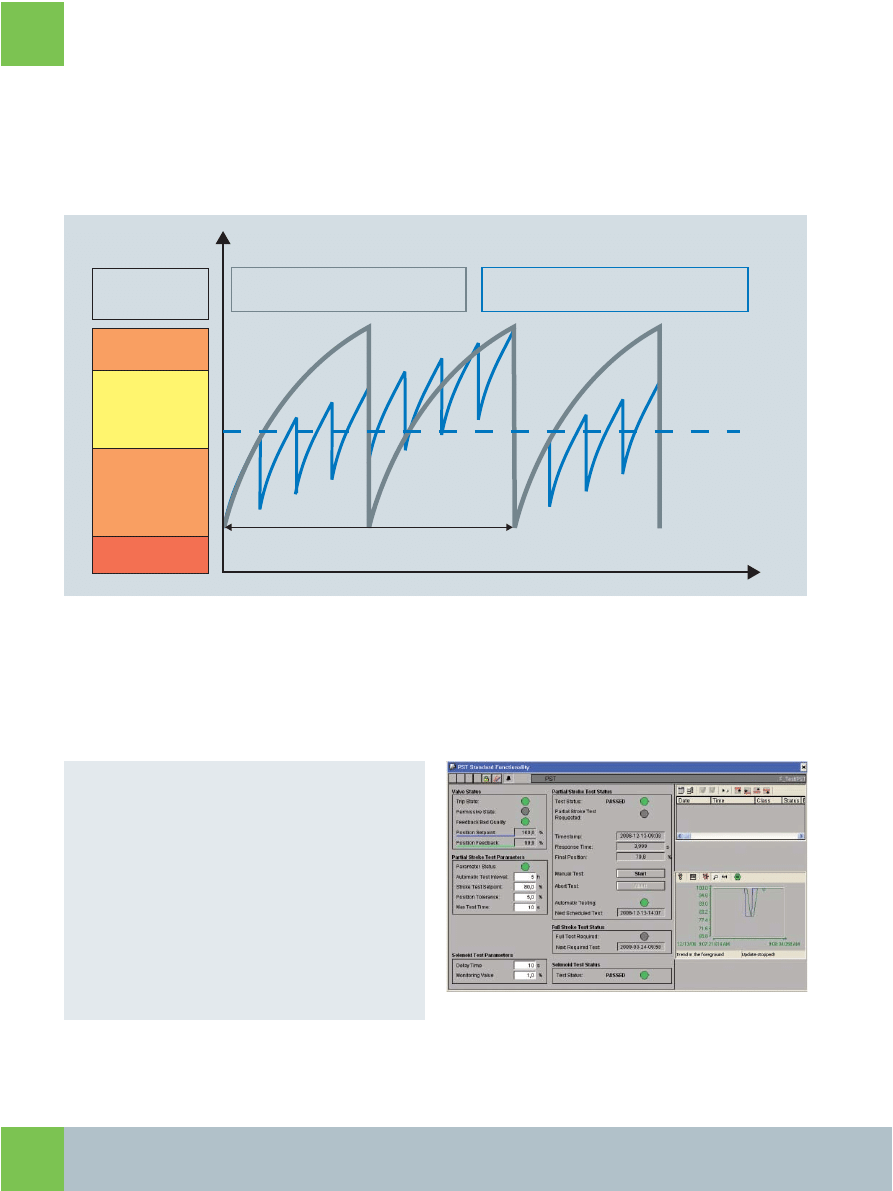
32
Application examples
Partial Stroke Test extends the test interval for the Full Stroke Test from one to two years
Function blocks
■
F_PST carries out the Partial Stroke Test
■
PST provides the alarms and events for the operator station
■
Option: F_SOLENOID tests the solenoid valve
■
Option: PST_CALC calculates the time of the next Full
Stroke Test
Faceplate for the SIMATIC PCS 7 operator system
PFD (t)
Without PST
Proof Test annually = SIL 2
With PST (4 x year)
Proof Test every 2 years = SIL 2
IEC 61508
SIL 1
SIL 2
SIL 3
SIL 4
Proof Test interval
Time
PFDavg
Advantages of the Partial Stroke solution from Siemens
■
Online valve test without interfering with production
■
Test covering different types of failure
■
Preventive diagnostics
■
More flexible tests and longer test intervals
■
Minimization of duration for bypassing the ESD valve
or for process shutdown
■
Lower failure probability of valve when required
■
Feedbacks concerning Full Stroke Tests required to
retain the SIL
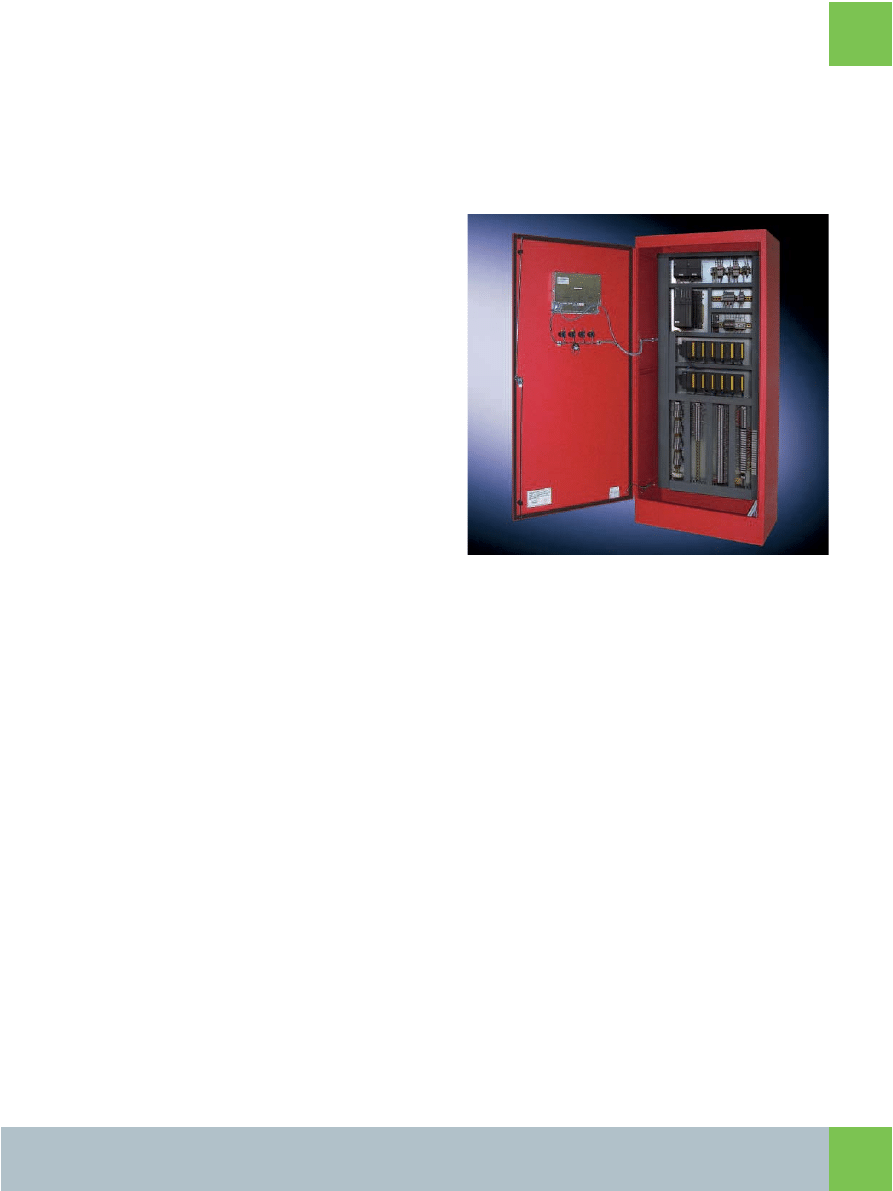
Application examples
33
Applications for protection against excess pressure, fire and gas
as well as for burner management
High Integrity Pressure Protection System (HIPPS)
The High Integrity Pressure Protection System is the specific
application of a Safety Instrumented Systems (SIS) for protec-
tion against overpressure. It can be used as an alternative to
pressure reducers according to API 521 and ASME code 2211,
Section VIII, Paragraphs 1 and 2.
On the basis of the Safety Integrated Systems, Siemens has
developed complex HIPPS solutions for various applications in
cooperation with solution providers:
www.siemens.com/process-safety
Burner Management Systems
Burner Management Systems (BMS) are defined according to
EN 298 and NFPA 85 (2001) as "Control systems for safe com-
bustion, for supporting operating personnel when starting-up
and shutting-down fuel conditioning and firing plants, and for
preventing malfunctions and damage on these plants".
Their wide range extends from very small systems for boilers
with single burners up to very large systems for power plant
boilers.
Siemens offers burner libraries as well as complete solutions
with TÜV-certified function blocks for the SIMATIC S7-400FH
and S7-300F controller platforms.
Example of a control cabinet configuration
Fire and gas
Systems for protection against fire and gas play an important
role in the total protection concept of industrial plants for ex-
ploitation, processing and transportation of petroleum, petro-
chemicals or dangerous gases.
They must reliably detect and signal fires and/or gas leakages,
even under adverse conditions such as failure of the main
power supply. To reduce subsequent damage, they are also
partially able to automatically initiate appropriate counter-
measures such as firefighting or drawing out of a gas. The
Safety Integrated System is certified for this in line with the
required safety standards EN 54 and NFPA 72.
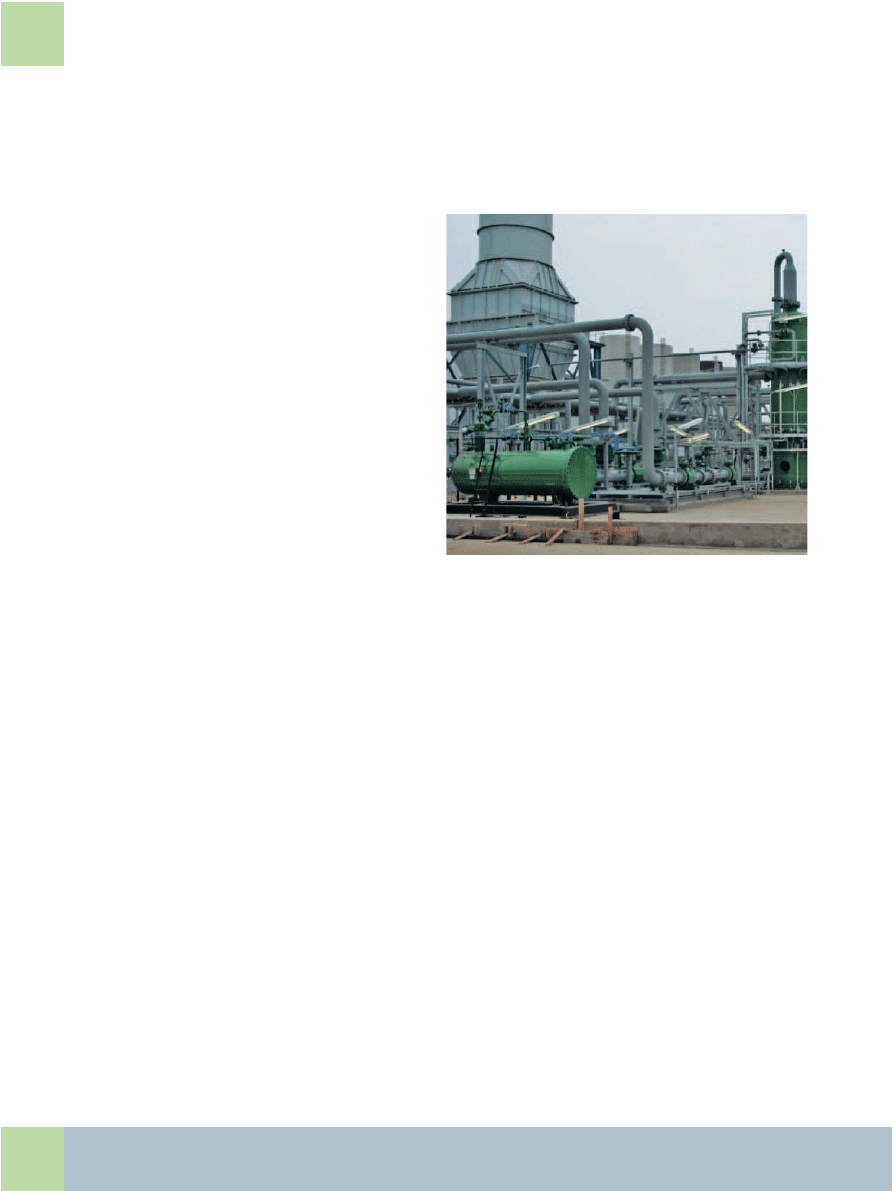
34
Reference projects
References in oil & gas and chemical industries
Whether during power generation, oil and gas exploitation, in
refineries, in the chemical, petrochemical or pharmaceutical
industries: on the basis of our sound know-how and compre-
hensive experience, we have already implemented a large
number of turnkey process safety solutions. These have
proven themselves in everyday use worldwide.
Energy:
Afam gas purification plant of the Shell Petroleum
Development Company (SPDC) Nigeria
SPDC has installed a gas conditioning plant to guarantee
the quality of gas supply to an existing State owned 270 MW
power station, subject to a sale & purchase agreement with
SPDC, and to an SPDC new build 650 MW power station due
on stream in Mid 2007.
SPDC Nigeria chose the integrated, fault-tolerant and
redundant safety and process control system PCS 7 for the
190 mmscf/d gas conditioning plant. The system controls all
emergency shut downs as well as the fire detection system
and gas leak detection system and has to comply strictly to
safety standards.
The solution
■
Process control system SIMATIC PCS 7 with SIMATIC Safety
Integrated
■
Fault-tolerant and highly available SIMATIC S7-400FH con-
troller – with two fiber optic cables connected CPUs –
Type 417-4H, as well as communication processors for
the connection with PROFIBUS and Ethernet
■
Over two interface modules IM 153-2 High Feature,
decentralized I/Os of the periphery system ET 200M are
connected to PROFIBUS: seven I/O lines for measuring field
signals out of the Safety Instrumented System, Fire and Gas
as well as out of the common process automation
■
Safety-engineering and Safety Lifecycle Management via
SIMATIC Safety Matrix
■
Foot print optimized and cost-effective system architecture
thanks to Flexible Modular Redundancy
Especially important was the application of the SIMATIC Safety
Matrix. This efficient engineering tool simplifies the design
and implementation of the safety relevant application. Fur-
thermore it supports important parts of the Safety Lifecycle of
the system – from design and realization through to the oper-
ation and maintenance phase.
Afam gas purification plant of the Shell Petroleum Development Company
(SPDC) Nigeria
Refinery:
Hydrocracker at Repsol YPF in Tarragona, Spain
A further project in which Siemens could prove its sector com-
petence was the automation of the hydrocracker for Repsol
YPF in the refinery in Tarragona, Spain. The hydrocracker con-
verts the impressive quantity of 24,000 barrels of petroleum
into higher-quality products every day. The demands placed
on the SIS were correspondingly high. The tasks: interlocking
of the two furnaces, motor control and monitoring of tank lev-
els, as well as emergency shutdown of five compressors for
controlling the exhaust stack and the furnaces.
The solution
■
SIMATIC PCS 7 process control system with SIMATIC Safety
Integrated
■
Two SIMATIC S7-400FH controllers
■
1,900 safety-related inputs and outputs with SIMATIC
ET 200M remote I/Os
■
Plant configuration
The two SIMATIC S7-400FH controllers ensure that the plant
operates within the approved range at all times. Using the
new hydrocracker, Repsol YPF could significantly increase its
production of petrol, diesel and other high-quality petrochem-
ical products. The fuels from Tarragona of course also satisfy
the EC environmental directives.
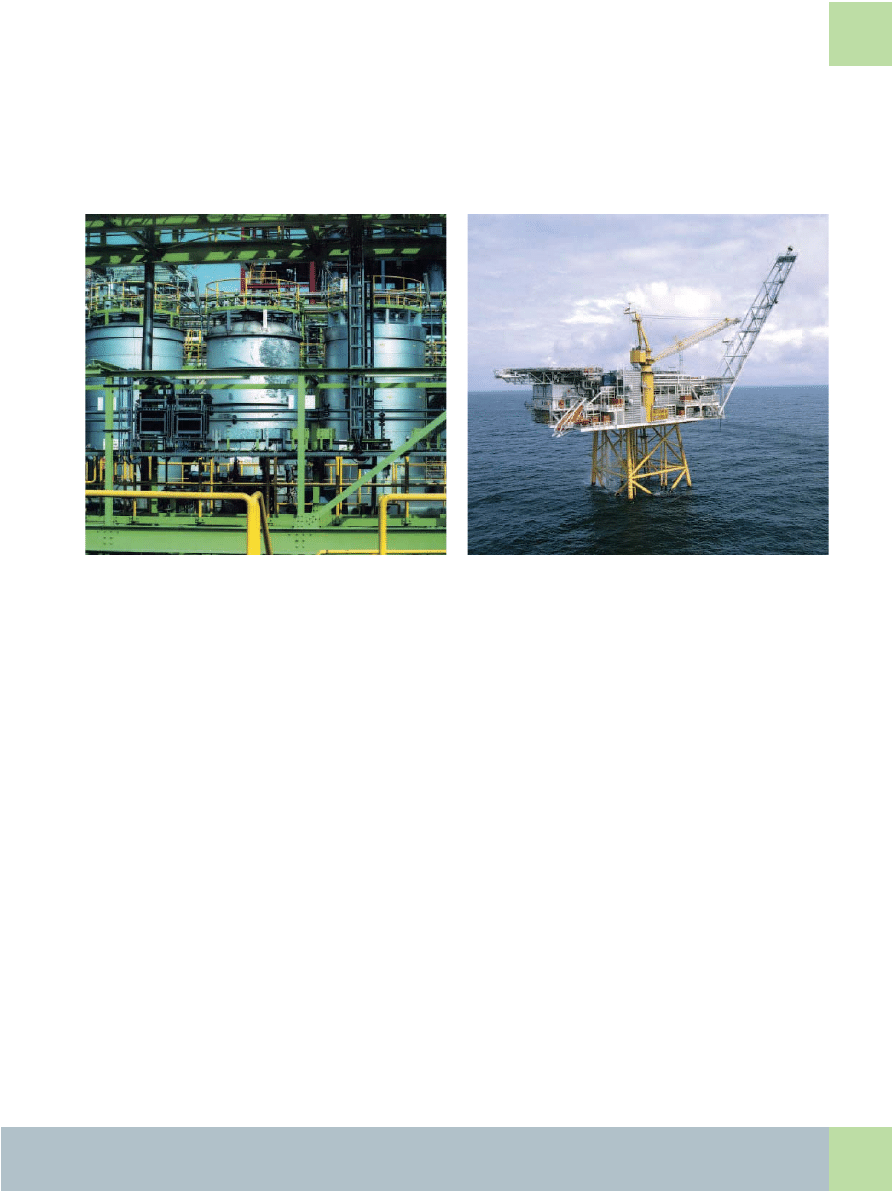
Reference projects
35
Bayer in Dormagen, Germany
Chemical industry:
production of pesticides at Bayer in Dormagen, Germany
In their new multipurpose plant in Dormagen, it was particu-
larly important for Bayer Crop Science AG to produce a unifor-
mity with SIMATIC PCS 7 from the field level up to the ERP level
(SAP). Bayer decided in favor of a control system solution with
integral safety technology – for 35 process engineering
plants, 240 units and 4,500 measuring points.
The solution
■
SIMATIC PCS 7 process control system with
SIMATIC Safety Integrated
■
53 SIMATIC S7-400FH controllers
■
1,000 safety-related inputs and outputs with
SIMATIC ET 200M remote I/Os
■
Plant configuration
Safety Integrated results in a reduction in engineering costs
over the complete lifecycle of the multipurpose plant. Thanks
to its high degree of flexibility, production can be adapted to
modified requirements significantly simpler and faster. Main-
tenance and modification work has become simpler as a result
of the unit-specific assignment of the controllers (one control-
ler per plant unit).
Statoil offshore platform, Norway
Oil and gas:
Statoil offshore platform, Norway
In order to reliably satisfy all safety-critical requirements for
its Huldra unmanned offshore oil platform in the North Sea,
Statoil, the largest Norwegian mineral oil company, applies
fire and gas warning systems as well as emergency shutdown
systems. One of the reasons: The SIMATIC S5 system already
installed proved its excellence in the past.
The solution
■
Five SIMATIC S7-400FH controllers
■
3,000 fail-safe inputs and outputs via
SIMATIC ET 200M
■
Plant configuration
The project was the beginning of a new controller generation
with integral safety engineering at Statoil. Since then, 20 fur-
ther platforms have been equipped with SIMATIC S7-400FH.
The large economical advantage: the user programs could be
reused for all platforms.

36
Overview of product and ordering data
S7-400FH controllers
SIMATIC S7-400FH controllers as AS bundles for SIMATIC PCS 7
(preferred configurations including S7 F Systems RT license)
In the context of SIMATIC PCS 7, the SIMATIC S7-400FH con-
trollers are available as completely assembled and tested
AS bundles. By selecting preconfigured ordering units, you
can define the configuration of the AS bundles and their order
numbers in interactive mode.
A configurator available in the catalog and in the online order-
ing system "A&D Mall" on the Internet (www.siemens.com/
automation/mall) provides you with effective support. In or-
der to help you when selecting preferred configurations,
these are listed additively together with their complete order
number.
The ordering units of the AS bundles and the preferred config-
urations are also listed in the SIMATIC PCS 7 Catalog ST PCS 7
(as of November 2007 issue). The ordering data of the individ-
ual components are listed in the Catalogs ST PCS 7 and ST 70.
Both catalogs are available on the Internet at:
www.siemens.com/simatic/printmaterial
SIMATIC CPU S7-400H
AS types
AS 412F
AS 414F
AS 417F
AS 412FH
AS 414FH
AS 417FH
CPU redundancy
No, 1 CPU
Yes, 2 CPUs (fault-tolerant)
Basic hardware
AS 412-3-1H
AS 414-4-1H
AS 417-4-1H
AS 412-3-2H
AS 414-4-2H
AS 417-4-2H
Order No. stem of
hardware
6ES7 654-8AB01-
3BX. / -3GX.
6ES7 654-8AB02-
3BX. / -3GX.
6ES7 654-8CF01-
3BX. / -3GX.
6ES7 654-8CF02-
3BX. / -3GX.
6ES7 654-8EN01-
3BX. / -3GX.
6ES7 654-8EN02-
3BX. / -3GX.
6ES7 656-8AB31-
1EX. / -1GX.
6ES7 656-8AB32-
1EX. / -1GX.
6ES7 656-8CF31-
1EX. / -1GX.
6ES7 656-8CF32-
1EX. / -1GX.
6ES7 656-8EN31-
1EX. / -1GX.
6ES7 656-8EN32-
1EX. / -1GX.
CPU type
CPU 412-3H
CPU 414-4H
CPU 417-4H
Component of the AS bundle
AS 412F (1 x) / AS 412FH (2 x)
AS 414F (1 x) / AS 414FH (2 x)
AS 417F (1 x) / AS 417FH (2 x)
Technical setup
S7-400 with distributed I/O
S7-400 with distributed I/O
S7-400 with
distributed I/O
Load memory, RAM (integrated /
memory card)
256 KB / up to 64 MB
256 KB / up to 64 MB
256 KB / up to 64 MB
Main memory
■
Total
■
For program
■
For data
768 KB
512 KB
256 KB
2.8 MB
1.4 MB
1.4 MB
30 MB
15 MB
15 MB
Execution time
75 ns
45 ns
18 ns
Number of F I/Os
Approx. 100
Approx. 600
Approx. 3000
Bit memories
8 KB
8 KB
16 KB
Integrated interfaces
■
Number and type
■
Number of DP segments
1 (MPI/DP)
1
2 (MPI / DP and DP)
2
2 (MPI / DP and DP)
2
Dimensions (WxHxD) in mm
50 x 290 x 219
50 x 290 x 219
50 x 290 x 219
Order No. stem
6ES7 412-3H.
6ES7 414-4H.
6ES7 417-4H.
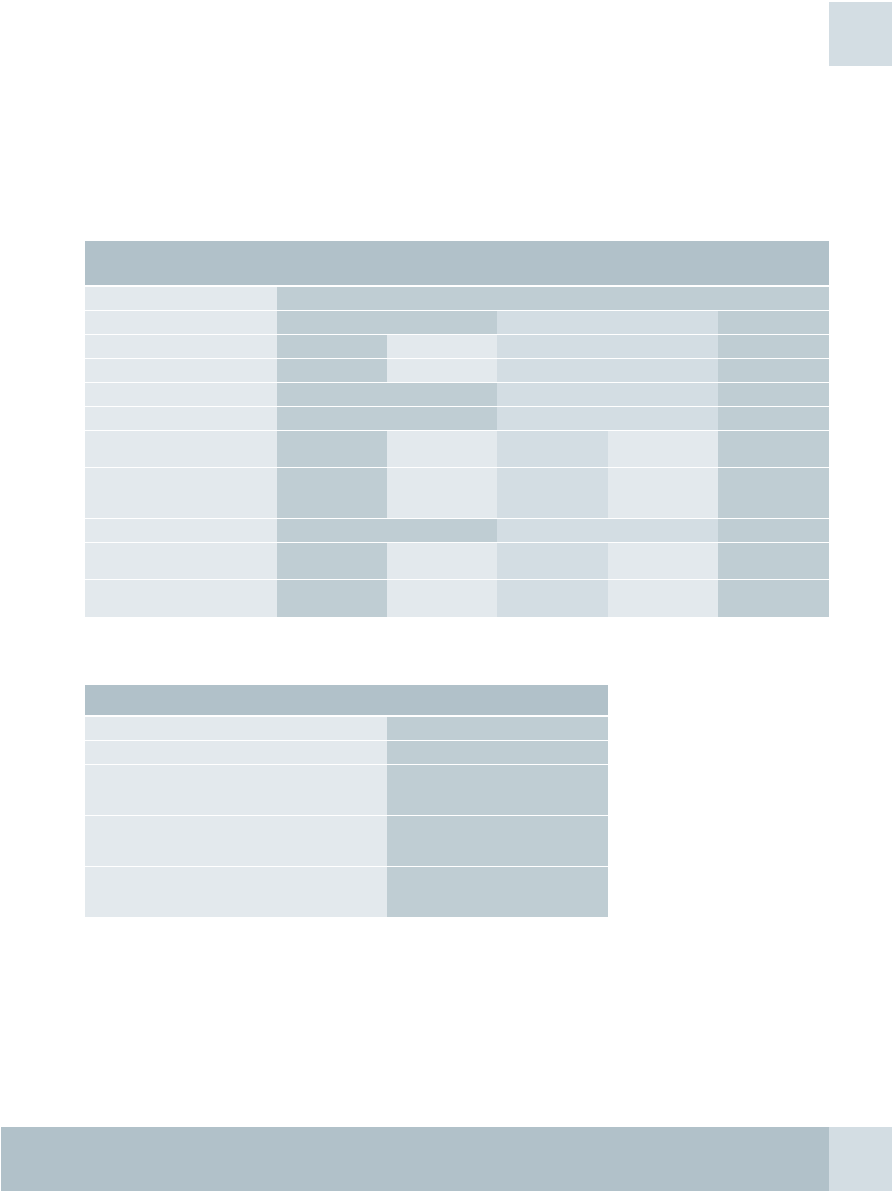
Overview of product and ordering data
37
S7-300F controllers
Software components
SIMATIC S7-300F controller
1)
As SIPLUS component also for extended temperature range -25 ... +60 °C and corrosive atmosphere/condensation (www.siemens.com/siplus)
Software components for engineering, runtime mode and safety lifecycle management
CPU type
CPU 315F-2
DP
CPU 315F-2
PN/DP
CPU 317F-2
DP
CPU 317F-2
PN/DP
CPU 319F-3
PN/DP
Technical setup
S7-300 with distributed I/O or central, safety-related I/O
Load memory (plug-in)
64 KB ... 8 MB
64 KB ... 8 MB
8 MB
Main memory
192 KB
256 KB
1 MB
1.4 MB
F operations
36 K
50 K
200 K
280 K
Number of F I/Os
Approx. 300
Approx. 500
Approx. 1000
Bit memories
2 KB
4 KB
8 KB
Fieldbus connection
PROFIBUS (DP)
PROFIBUS (DP),
PROFINET (PN)
PROFIBUS (DP)
PROFIBUS (DP),
PROFINET (PN)
PROFIBUS (DP),
PROFINET (PN)
Integrated interfaces
■
Number and type
■
Number of DP segments
2 (MPI and DP)
1
2 (DP/MPI and PN)
1
2 (DP/MPI and DP)
2
2 (DP/MPI and PN)
1
3 (DP/MPI, DP, PN)
2
Dimensions (WxHxD) in mm
40 x 125 x 130
80 x 125 x 130
120 x 125 x 130
Order No. stem
Standard version
6ES7 315-6FF.
6ES7 315-2FH.
6ES7 317-6FF.
6ES7 317-2FK.
6ES7 318-3FL.
Order No. stem
SIPLUS version
1)
6AG1 315-6FF.
--
6AG1 317-6FF.
--
--
Name
Order No. stem
S7 F Systems / S7 F Systems upgrade
6ES7 833-1CC01-0.
S7 F Systems RT license (part of the AS bundles)
6ES7 833-1CC00-6.
Safety Matrix Editor including Safety Matrix Viewer
Safety Matrix Tool
Safety Matrix Viewer
6ES7 833-1SM0.
6ES7 833-1SM4.
6ES7 833-1SM6.
Partial Stroke Test function blocks and faceplates
■
Engineering license and RT license for one AS
■
RT license for a further AS
6BQ2 001-0CA.
6BQ2 001-0CB.
Burner libraries, function blocks
■
For SIMATIC S7-400FH controllers
■
For SIMATIC S7-300F controllers
9AL3 100-1AA1.
9AL3 100-1AD5.
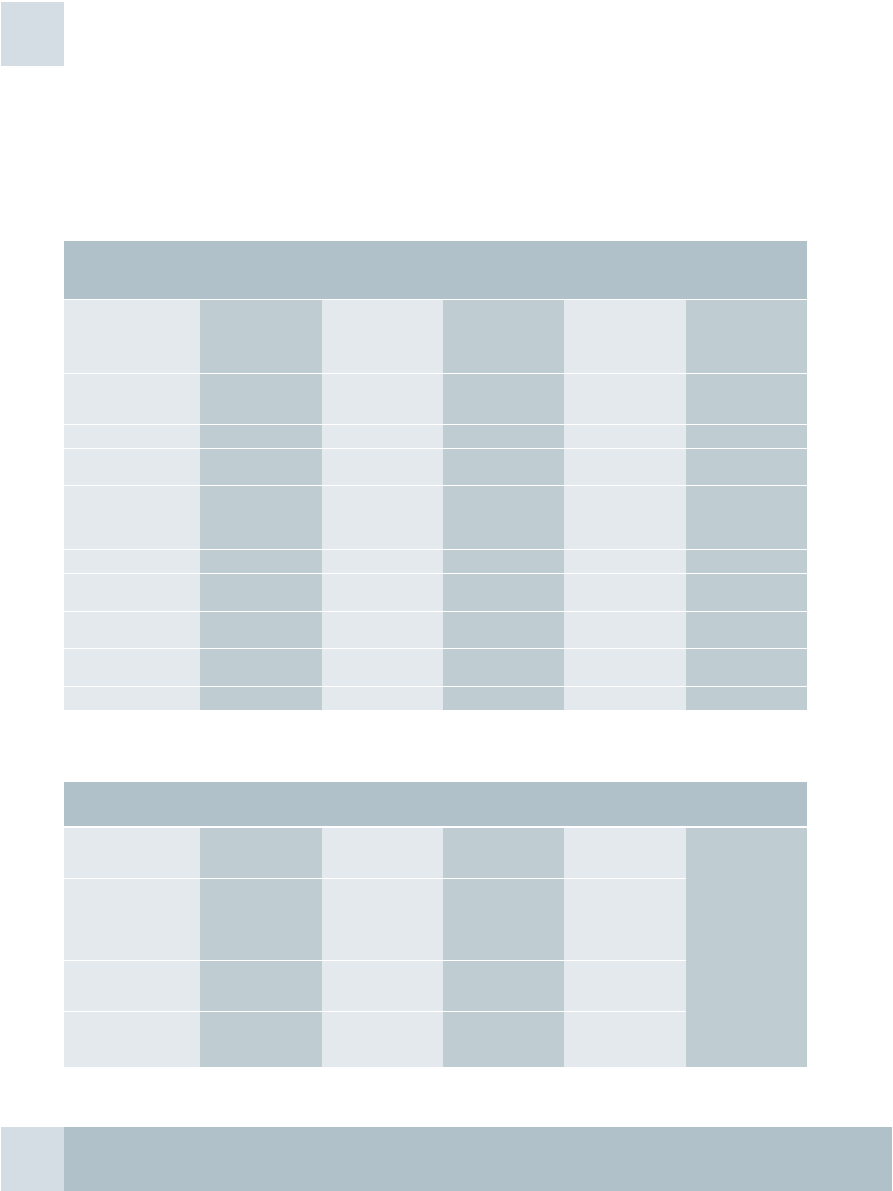
38
Overview of product and ordering data
ET 200M F signal modules
SIMATIC PCS 7 MTA terminal modules
F signal modules for ET 200M on S7-300F and S7-400FH
SIMATIC PCS 7 MTA terminal modules for the sensor/actuator connection to F modules of the ET 200M
Module types
Digital input
SM 326F
Digital input
SM 326F NAMUR
[EEx ib]
Digital output SM 326F
Analog input
SM 336F HART
Max. number of
inputs/outputs
24 (1-channel for
SIL 2 sensors)
12 (2-channel for
SIL 3 sensors)
8 (1-channel)
4 (2-channel)
10, electrically iso-
lated in groups of 5
P/P switching
8, electrically isolat-
ed in groups of 4
P/M switching
6 (1-channel)
15 bits + sign
2-wire or 4-wire con-
nection
Max. achievable safety
class to IEC 61508 / EN
954-1
1-channel: SIL 2
2-channel: SIL 3
1-channel: SIL 2
2-channel: SIL 3
SIL 3
SIL 3
SIL 3
Input or output voltage
24 V DC
NAMUR
24 V DC
24 V DC
--
Input or output current
--
--
2 A per channel
with "1" signal
2 A per channel
with "1" signal
4 ... 20 mA or
0 ... 20 mA
Short-circuit-proof
sensor supply
4 for 6 channels
each, electrically iso-
lated in groups of 2
8 for 1 channel
each,
electrically isolated-
from each other
--
--
6 for 1 channel each
HART communication
No
No
No
No
Yes (optional)
Redundancy mode
Module redundancy
Module redundancy
Module and channel
redundancy
No
Module and channel
redundancy
Module and channel di-
agnostics
Yes
Yes
Yes
Yes
Yes
Dimensions (WxHxD) in
mm
80 x 125 x 120
80 x 125 x 120
80 x 125 x 120
80 x 125 x 120
40 x 125 x 120
Order No. stem
6ES7 326-1BK.
6ES7 326-1RF.
6ES7 326-2BF0.
6ES7 326-2BF4.
6ES7 336-4GE.
MTA type
Input/output
range
I/O redundancy
Order No.
MTA
Order No.
ET 200M module
Order No. connec-
tion cable
6 channels F AI (safety-
related)
4 ... 20 mA
Yes
6ES7 650-1AH51-5.
6ES7 336-1HE00-0.
(as of product ver-
sion 6)
6ES7 922-3BD00-
0AS. (3 m)
6ES7 922-3BJ00-
0AS. (8 m)
24 channels F DI (safe-
ty-related)
24 V DC
Yes
6ES7 650-1AK11-7.
6ES7 326-1BK00-0.
and
6ES7 326-1BK01-0.
(as of product
version 1)
10 channels F DO (safe-
ty-related)
24 V DC, 2 A
Yes
6ES7 650-1AL11-6.
6ES7 326-2BF01-0.
(as of product
version 2)
10 channels F DO re-
lays (safety-related)
110 ... 220 V AC,
5 A;
24 V DC, 5 A
Yes
6ES7 650-1AM31-6.
6ES7 326-2BF01-0.
(as of product
version 2)
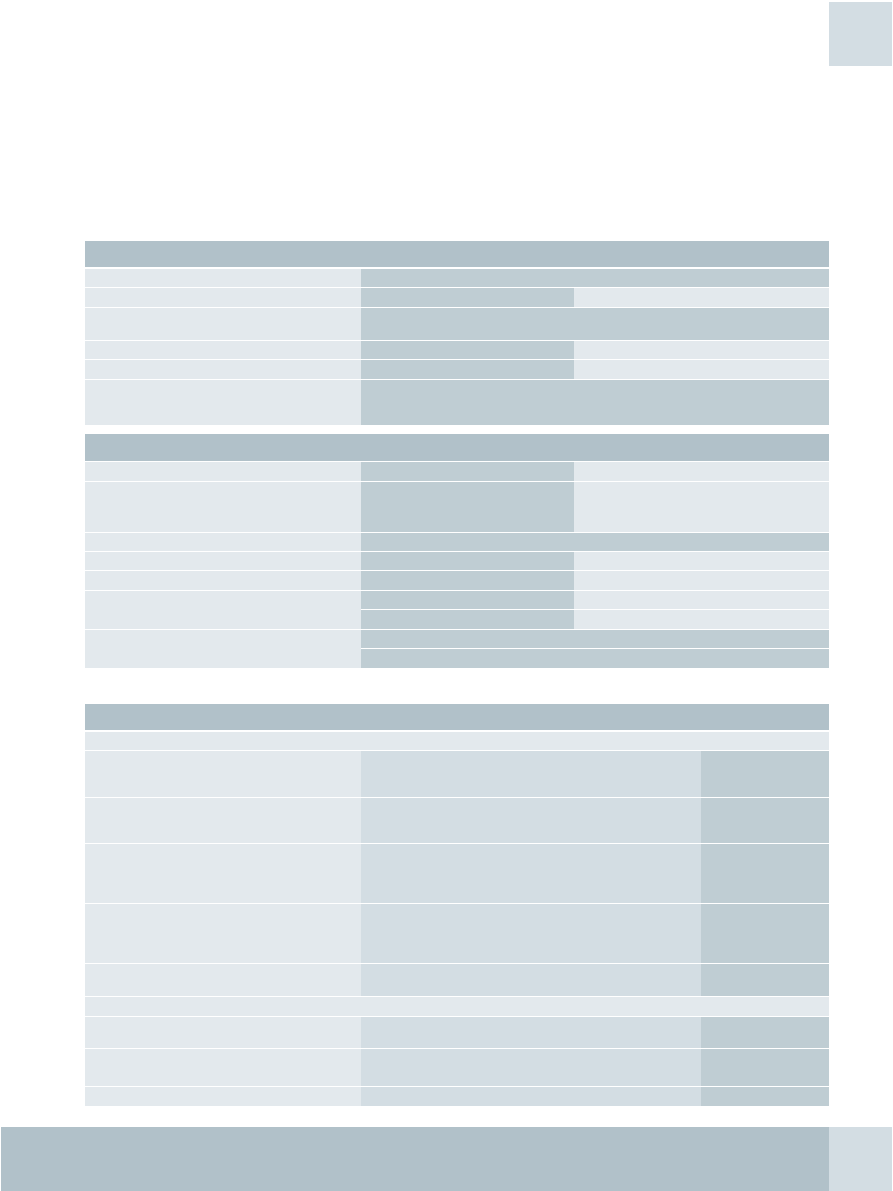
Overview of product and ordering data
39
ET 200S distributed I/O system
SIMATIC PCS 7 safety packages
Power modules and safety-related electronics modules (F modules) for ET 200S on S7-300F and S7-400FH
SIMATIC PCS 7 safety packages
Power modules for electronics modules
Module types
PM-E
Supply voltage
24 V DC/10 A
24 … 48 V DC; 24 … 230 V AC; with fuse
Application
All types of electronics module, including safety-related (4/8 F DI, 4 F DO);
limitations through voltage range
Diagnostics
Load voltage
Load voltage and fuse
Order No. stem of power module
6ES7 138-4CA.
6ES7 138-4CB.
Order No. stem of terminal module
6ES7 193-4CC. (2 x 3 terminals), AUX1 with through-connection to left
6ES7 193-4CD. (2 x 3 terminals), AUX1 interrupted to left
6ES7 193-4CE. (2 x 2 terminals)
Safety-related electronics modules (F modules)
Module types
Digital input module 4/8 F DI
Digital output module 4 F DO
Number of I/Os
4 (2-channel for SIL 3 sensors)
8 (1-channel for SIL 2 sensors)
4 with 24 V DC/2 A, P/M switching
1)
, up to SIL 3
1)
P/M: for ungrounded loads
(mass and earth separated)
Input or output voltage
24 V DC
Module and channel diagnostics
Yes
Yes
Order No. stem of electronics module
6ES7 138-4FA.
6ES7 138-4FB.
Order No. stem of terminal module
6ES7 193-4CF. (4 x 4 terminals)
6ES7 193-4CF. (4 x 4 terminals)
6ES7 193-4CG. (4 x 6 terminals)
6ES7 193-4CG. (4 x 6 terminals)
Order No. stem of power module (see table of
power modules for associated terminal modules)
6ES7 138-4CA.
6ES7 138-4CB.
Name
Order No. stem
SIMATIC PCS 7 Safety ES Packages
SIMATIC PCS 7 Safety ES Package for AS/OS,
250 POs
■
SIMATIC PCS 7 Engineering Software with AS/OS engineer-
ing and runtime license for 250 POs
■
S7 F Systems
6ES7 651-6AA07-0.
SIMATIC PCS 7 Safety ES Package for AS/OS,
unlimited POs
■
SIMATIC PCS 7 Engineering Software with AS/OS engineering
license for unlimited POs and AS runtime license for 600 POs
■
S7 F Systems
6ES7 651-6AF07-0.
SIMATIC PCS 7 Safety Matrix ES Package for AS/OS,
250 POs
■
SIMATIC PCS 7 Engineering Software with AS/OS engineer-
ing and runtime license for 250 POs
■
SIMATIC Safety Matrix Tool
■
S7 F Systems
6ES7 651-6BA07-0.
SIMATIC PCS 7 Safety Matrix ES Package for AS/OS,
unlimited POs
■
SIMATIC PCS 7 Engineering Software with AS/OS engineering
license for unlimited POs and AS runtime license for 600 POs
■
SIMATIC Safety Matrix Tool
■
S7 F Systems
6ES7 651-6BF07-0.
SIMATIC PCS 7 Safety Matrix ES Extension Package
■
SIMATIC Safety Matrix Tool
■
S7 F Systems
6ES7 651-6BX07-0.
SIMATIC PCS 7 Safety Matrix OS Packages
SIMATIC PCS 7 Safety Matrix OS Single Station
Package
■
SIMATIC PCS 7 OS Software Single Station, 250 POs
■
SIMATIC Safety Matrix Viewer
6ES7 652-6AA07-0.
SIMATIC PCS 7 Safety Matrix OS Client Package
■
SIMATIC PCS 7 OS Software Client
■
SIMATIC Safety Matrix Viewer
6ES7 652-6CX07-0.
SIMATIC PCS 7 Safety Matrix OS Extension Package
■
SIMATIC Safety Matrix Viewer
6ES7 652-6BX07-0.

Siemens AG
Automation and Drives
Industrial Automation Systems
P.O. Box 48 48
D-90327 Nuremberg
Germany
w w w. s i e m e n s . c o m / p ro c e s s - s a f e t y
The information provided in this brochure contains descriptions or characteris-
tics of performance which in case of actual use do not always apply as de-
scribed or which may change as a result of further development of the products.
An obligation to provide the respective characteristics shall only exist if ex-
pressly agreed in the terms of contract. Availability and technical specifications
are subject to change without prior notice.
All product designations may be trademarks or product names of Siemens AG
or supplier companies whose use by third parties for their own purposes could
violate the rights of the owners.
Su
bj
e
ct
t
o
c
h
ang
e w
it
h
out
p
ri
o
r no
ti
ce
| Or
d
e
r No
. E8
606
0-
A4
678
-A
181
-A
2-
760
0 | D
is
p
o
095
08 |
KB
100
7 5.
0 R
O
T
40 E
n
/ 8
1
5
1
0
6
| Pr
inte
d in G
e
rm
an
y
| ©
Sie
me
ns A
G
2
0
0
7
Further information
can be found on the Internet
You can find more detailed information in the SIMATIC Guide
manuals:
www.siemens.com/simatic-docu
You can order further documents on the topic of SIMATIC at:
www.siemens.com/simatic/printmaterial
More detailed technical documentation can be found at our
Service & Support Portal:
www.siemens.com/automation/support
For a personal discussion, you can locate your nearest contact
at:
www.siemens.com/automation/partner
In the A&D Mall you can place orders electronically via the
Internet:
www.siemens.com/automation/mall
Visit our process automation portal with comprehensive infor-
mation on process control engineering and process instru-
mentation from Siemens:
www.siemens.com/processautomation
Document Outline
- Safety Integrated for Process Automation
- Totally Integrated Automation
- Contents
- Safety engineering from Siemens
- Process automation with integrated safety
- Standardized, flexible safety products and solutions from a
- Safety lifecycle management
- Simple control system integration
- Variable fieldbus communication with integrated safety
- Flexible and scalable fault-tolerance
- Efficient safety lifecycle engineering
- The comprehensive range of products and services
- Integrated control & safety
- Safety Integrated fieldbus technology
- Flexible Modular Redundancy
- Cost-optimized safety through flexible and scalable fault tolerance
- Configuration versions with FMR
- SIMATIC controller for safety-related process applications
- S7-400FH and S7-300F controllers
- Versatile, distributed I/O systems
- ET 200M
- ET 200S
- Direct device interfacing via fieldbus
- Safe field instrumentation on the PROFIBUS PA
- Safety Lifecycle Management
- Application examples
- Reference projects
- Overview of product and ordering data
- Further information
Wyszukiwarka
Podobne podstrony:
krc2 ed05 safetybus en
Safety KR C4 en
Konferencja nt Ultras [2010, PDF, 332 KB, EN]
new employee safety orientation 1201643571904060 5
Safety net
Budzik Versa wielkość karty kredytowej instrukcja EN
G2 4 PW EN wn Rys 01
Manual Acer TravelMate 2430 US EN
Ćwiczenie 01 EN DI
eci en
BVSOI 3 001 E en
A Biegus projektowanie konctrukcji stalowych wg PN EN 1993 1 1 cz 1
Flavon Active dopping EN
5817 PN EN ISO IV 2007
Pisownia ę ą en em om
NS2 lab 4 4 7 en Configure Cisco IOS IPSec using Pre Shared Keys
PN EN 1990 2004 AC Podstawy projektowania konstrukcji poprawka
EN w9 wspolpraca z siecia
więcej podobnych podstron